#fashion museum catalogue
Explore tagged Tumblr posts
Text













History of Russian Costume
from the Eleventh to the Twentieth Century
catalogue compiled by T.S.Alyoshina, I.L.Vishnevakaya, L.V.Efimova, T.T.Korshunova, V.A.Malm,E.Yu.Moiseenko, M.M.Postnokova-Loseva,E.P.Chernukha
The Metropolitan Museum of Art, New York 1977, 116 pages, 14x21,5cm, ISBN 0-87099-160-4
euro 75,00
email if you want to buy [email protected]
The Glory of Russian Costume exhibition which this publication accompanies was created on the basis of materials drawn from the collections of leading Russian museums: the Pavlovsk Museum; the Arsenal Museum, Leningrad; the State Museums of the Kremlin, Moscow; the State Historical Museum, Moscow; and the State Hermitage Museum, Leningrad. At the time, the exhibition of Russian costume was shown abroad for the first time, but in Russia these items, along with an enormous number of others, are shown in their respective museums for visitors to enjoy. Costume, as part of the material culture of society, reflects the history of the people. In this way, this exhibition as presented to an American audience went far beyond the framework of a narrowly professional one, and is definitely of great interest to the widest circles of the population.
The exhibition acquaints the visitor with the traditional shapes of Russian clothing, as well as with the character of the later all-European type of costume in Russia. The collection includes more than 500 authentic examples of clothing dating from the eleventh to the beginning of the twentieth century. The art of Russian costume is arranged chronologically into three sections: Russian Costume from the Eleventh to the Seventeenth Century, Folk Costume from the Eighteenth to Early Twentieth Century, and Urban Costume from the Eighteenth to the Early Twentieth Century
29/11/24
#Russian Costume#fashion exhibition catalogue#Met New York 977#Collections of russian museums#fashion books#fashionbooksmilano
33 notes
·
View notes
Text
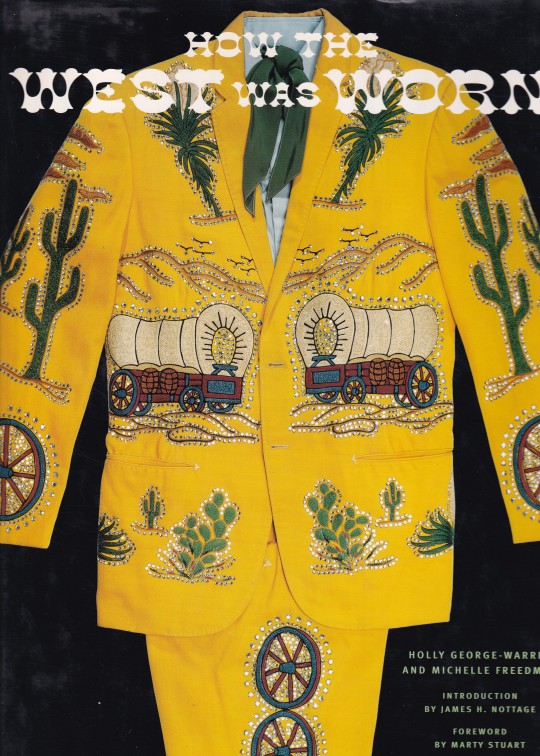
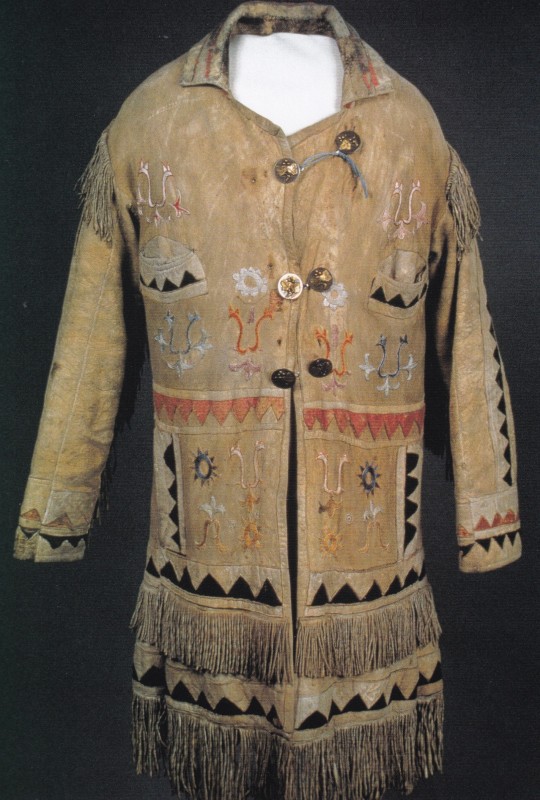
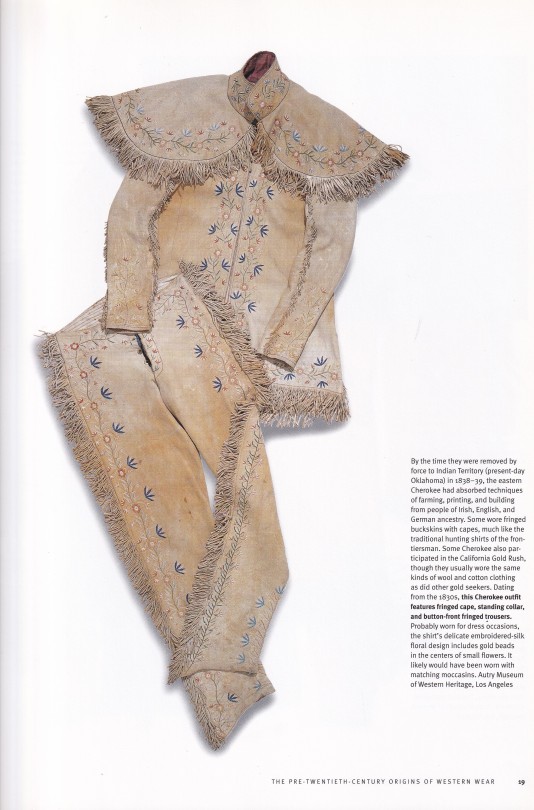
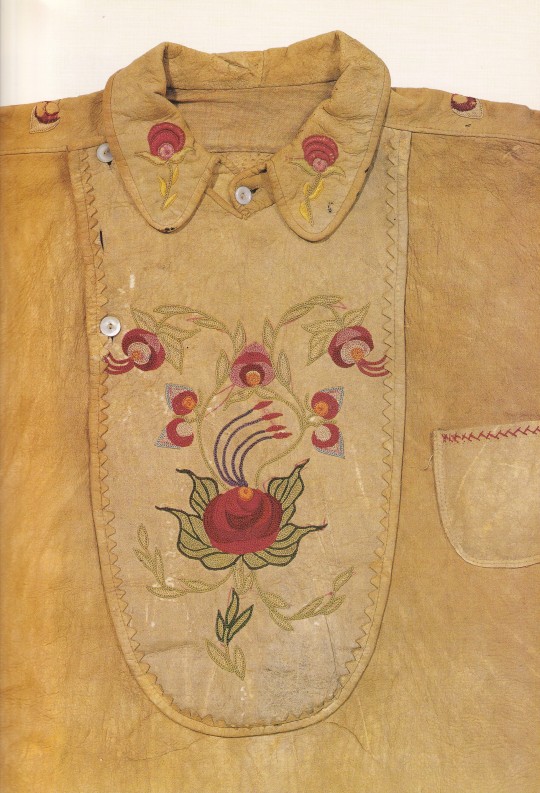


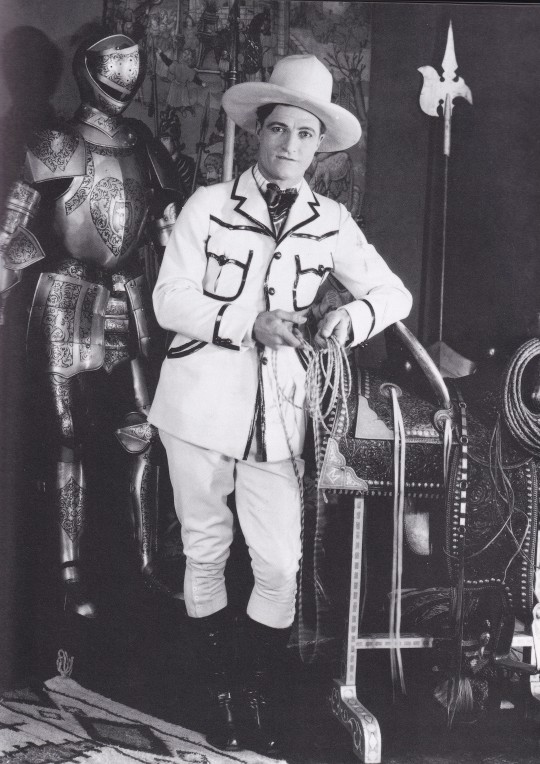
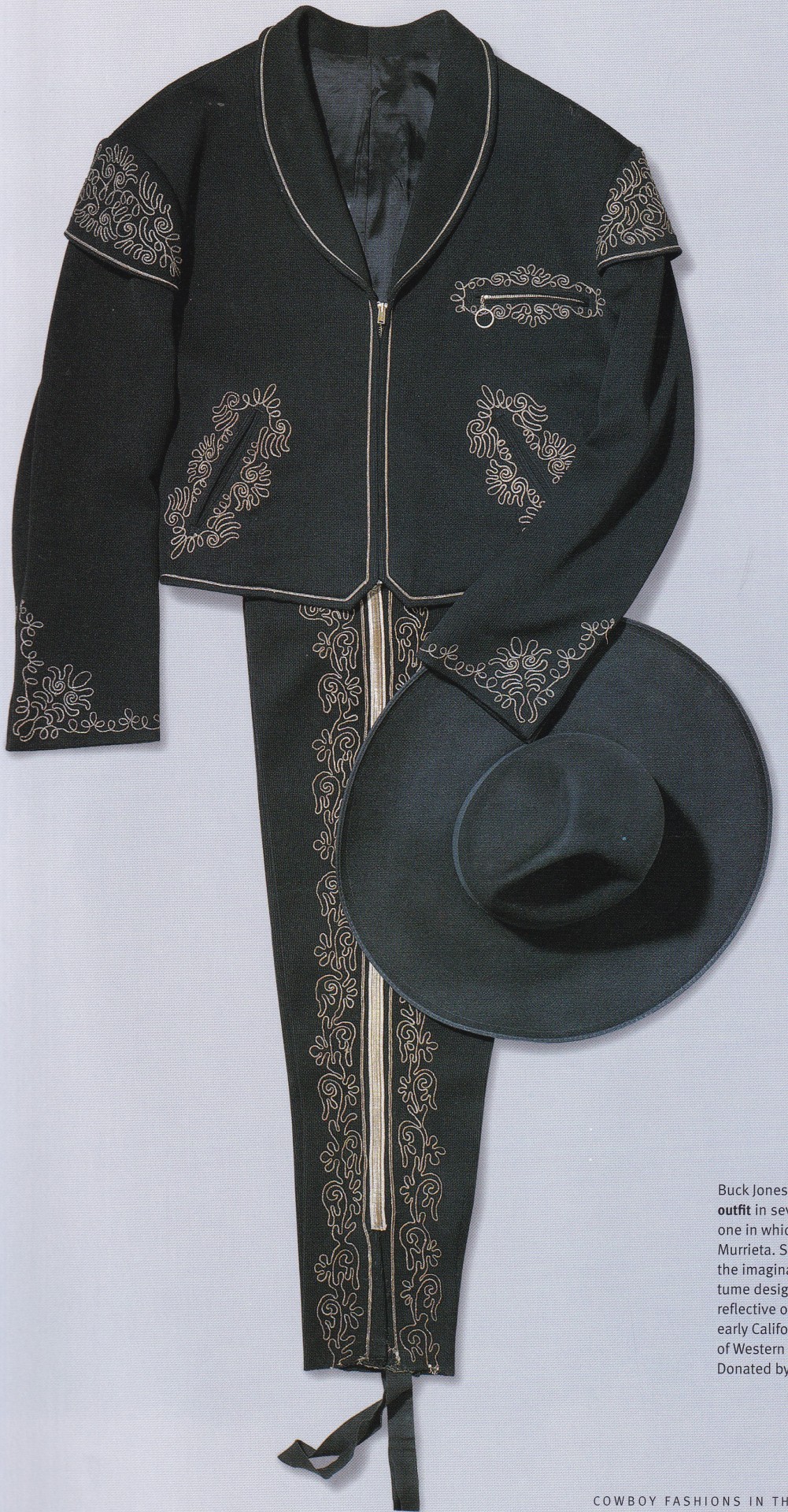
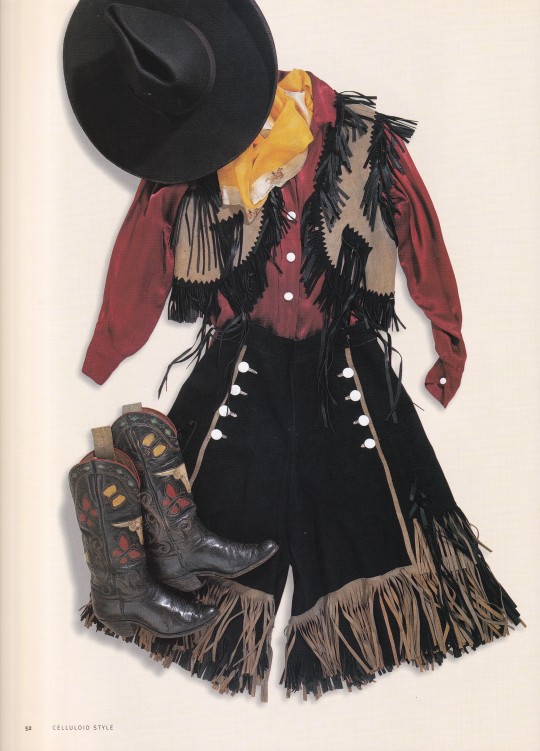
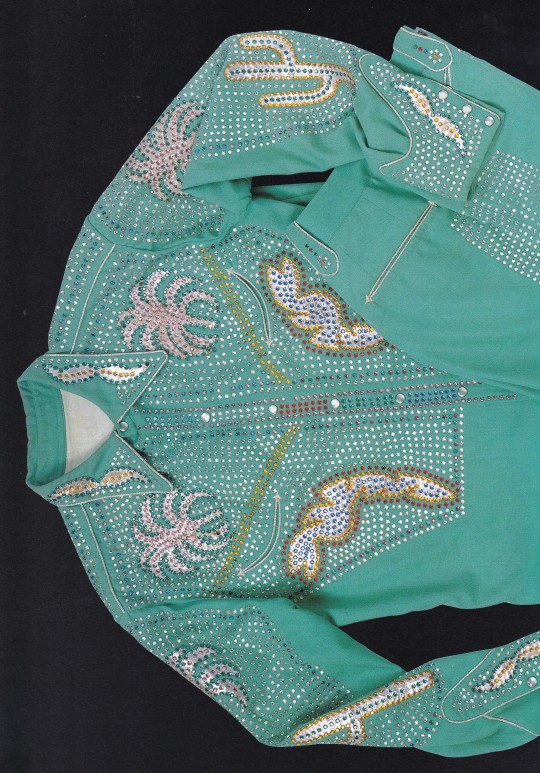
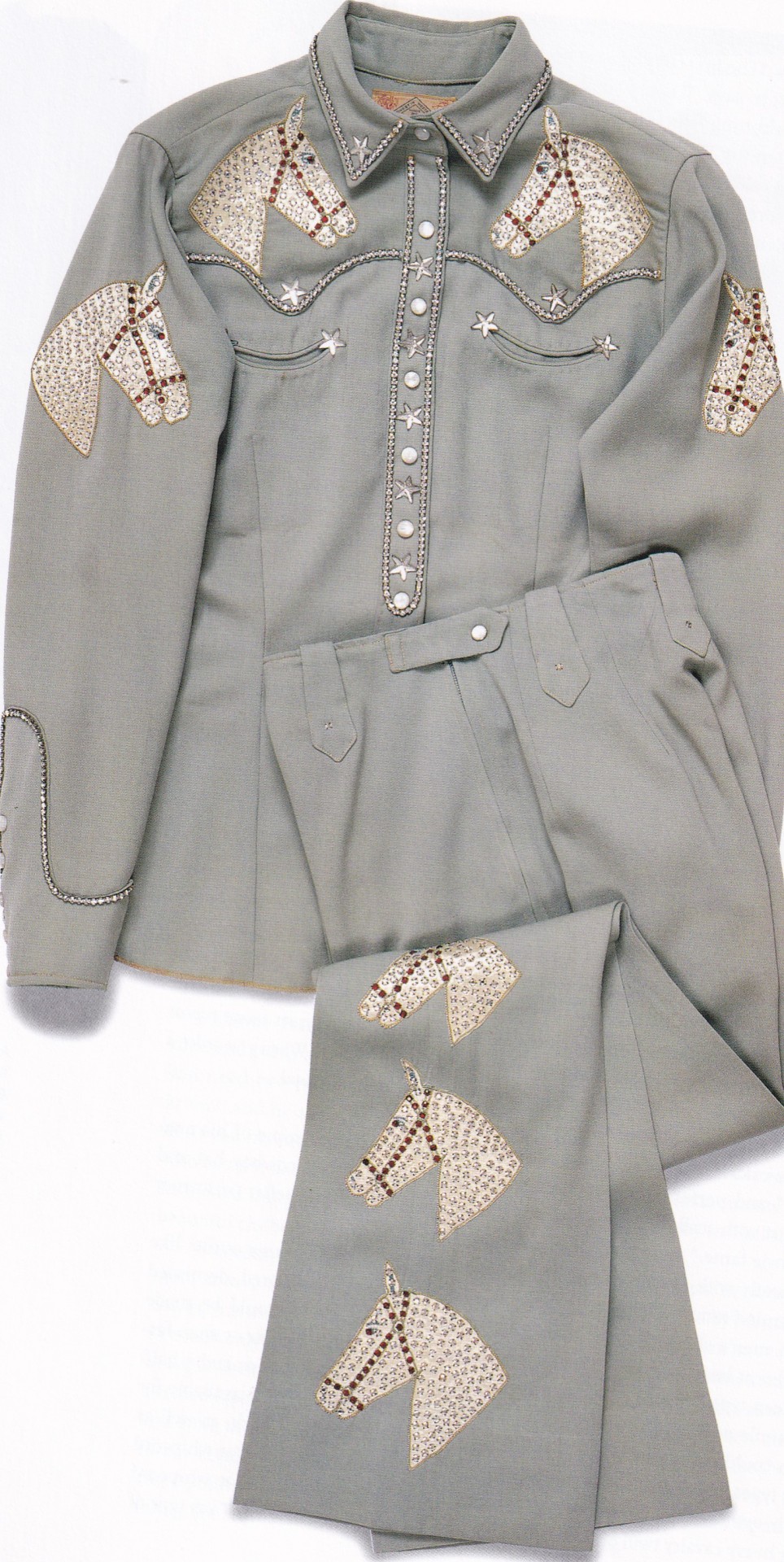
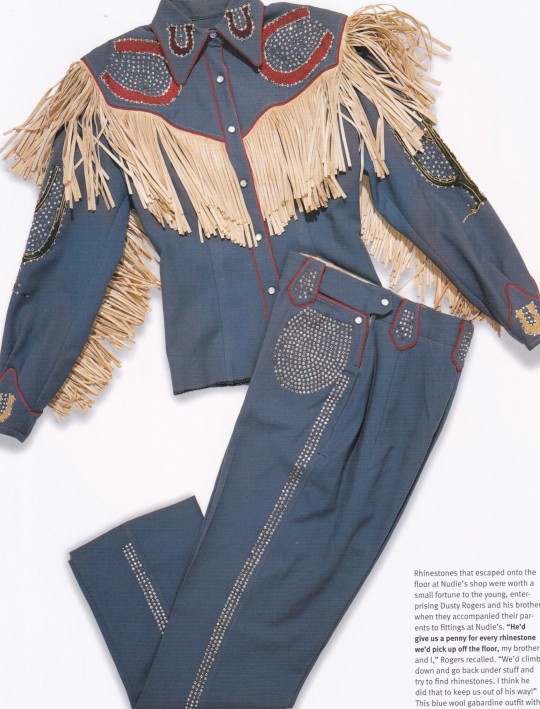

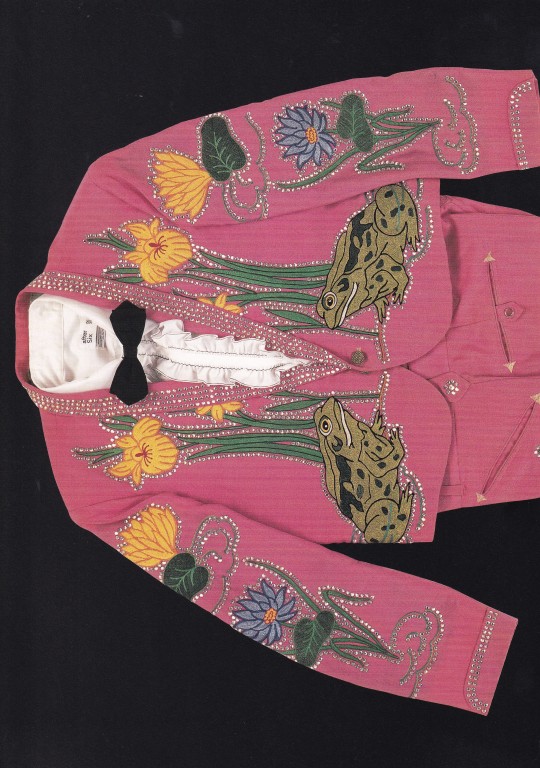
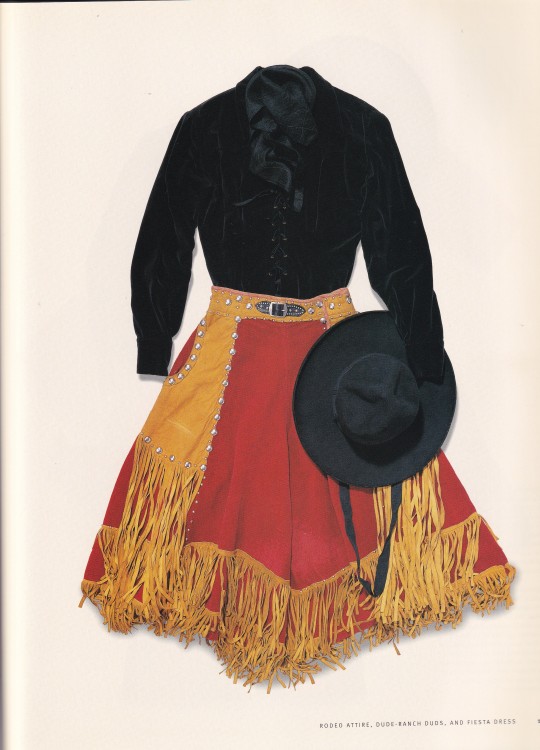
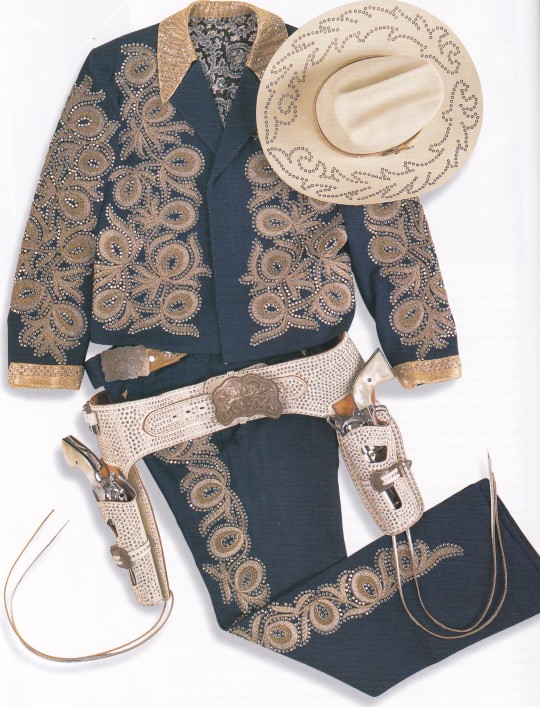
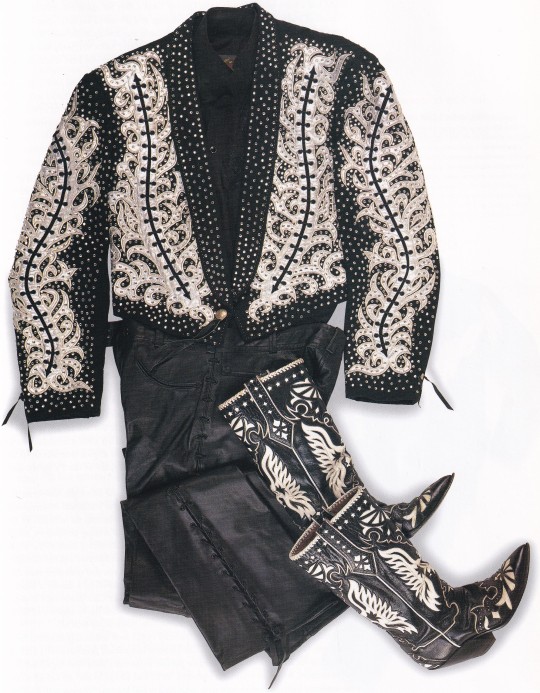
How the West was Worn
Holly George- Warren and Michelle Freedman
Introduction by James H.Nottage, Foreword byMarty Stuart
Abrams, New York 2001, 240 pages, 23,5x30,5cm, ISBN 0-8109-0615-5
euro 180,00
email if you want to buy [email protected]
To accompany an exhibition at the Autry Museum of Western Heritage, chief curator James Nottage briefly reviews the evolution of clothing that people actually wore in frontier America. Then a team of popular culture historians trace the versions that have appeared in movies, television, and concert stage throughout the 20th century
26/06/24
#how the West was Worn#fashion exhibition catalogue#Autrey Museum#Western heritage#cowboy fashion#western wear#fashion books#rare books#fashionbooksmilano
2 notes
·
View notes
Note
Some insight into the designs and fashion of the 20s would be so cool, especially since it's kinda hard these days to sift through just costume listing :'0
Yeah, sadly, the usefulness of a Google search is greatly diminished these days. You can still find articles written by actual human beings and genuine historical garments, but you have to wade through a lot of junky costumes and AI bullshit to get there. I can't possibly fully explain 1920s fashion here, though. It's a broad enough topic to write a sizable book about...which is why people have written many books about it. Check out some books. There are things you can get pretty cheap from resellers, everything from academic screeds about the politics behind the fashion trends of the time, to clothing catalogue compilations from the 20s, to giant coffee table books full of glorious photos.
Here's a PDF version of one of those clothing catalog collections. There's an entire preface about 1920s fashion in general too.
There are some pretty well made blogs about the topic out there as well. Vintage Dancer is one of them. The front of the site is unfortunately kind of cluttered with ads for costume apparel and modern clothing inspired by the 20s, but scroll past that to the historical bits and you'll find pertinent things.
There are some great fashion YouTubers too, like Karolina Zebrowska. Although she's not focused heavily on 1920s fashion, she talks a lot about early 20th century fashion in general. She also talks a lot about the historical context of those fashions.
Also, try online museum displays. The Met Museum has a searchable collection, for instance. Look up 1920s fashion, 1920s dresses, 1920s suits, etc.
Cameras were popular and accessible in the 1920s. Look at pictures of what people actually wore. You can find these images in free government photo archives, or licensing libraries like Getty Images (you don't have to license anything to look at it). And there's always Shorpy. Poor old, underappreciated Shorpy. Their archive is searchable.
1K notes
·
View notes
Text
April 20, Beijing, China, National Museum of China/中国国家博物馆 (Part 6 – Ancient Chinese Jade exhibition/中国古代玉器展 and part of The Power of Science and Technology exhibition/科技的力量展):
Starting with the Ancient Chinese Jade exhibition today, this is a Qing dynasty (1644 - 1911) Qianlong era (1736 - 1796) jade brush holder. It's impossible to tell from this angle (my bad lol), but the relief on this brush holder actually depicts the Sanxing/三星 (lit. "three stars"), which is the name of a group of three Daoist deities: Fuxing/福星 (lit. "Fortune Star"; Jupiter), Luxing/禄星 (lit. "Prosperity Star"; Mizar of Ursa Major), and Shouxing/寿星 (lit. "Longevity Star"; Canopus). These three gods are frequently depicted together for auspiciousness.
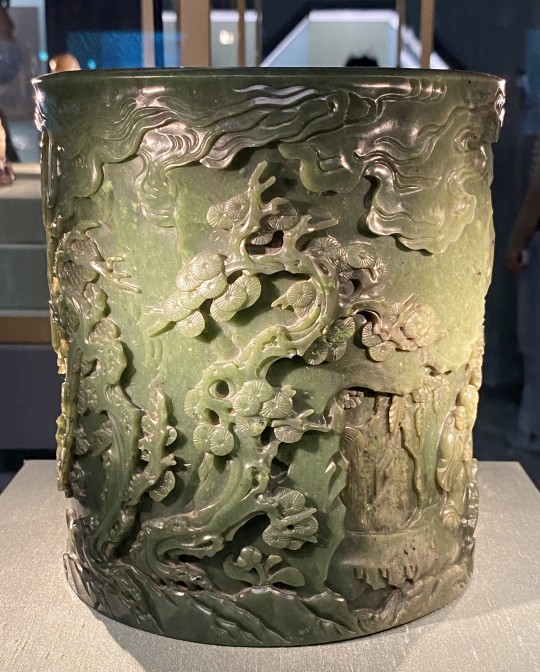
A Qing dynasty Qianlong era jade gaiwan/盖碗 (lit. "lidded bowl"), decorated with gold inscription of Qianlong Emperor's poetry and plum blossoms. Gaiwan are a specific type of Chinese tea cup that can be used to both infuse tea and drink tea, and may consist of three parts--a bowl, a lid, and a saucer. Because of this three-part structure, it's also called sancaiwan/三才碗, where the lid, bowl and saucer correspond to "heaven", "human", and "earth" respectively. Alternatively gaiwan can be more literal like the one here, which only has a bowl and a lid. Some say the gaiwan originated in Sichuan in Tang dynasty (618 - 907 AD), but evidence suggests that true gaiwan (with lid) only appeared in late Ming dynasty to early Qing dynasty (around 16th-17th century). Gaiwan was very popular in Qing dynasty and remains popular today.

Left: Ming dynasty (1368 - 1644) diancui/点翠 and jade ornament, with egrets and lotuses carved into the jade part. As mentioned before in the second historical fashion exhibition post, diancui (the blue parts) is a method of decoration that uses the iridescent feathers of kingfishers. Because all species of kingfishers are now protected by law, all diancui on the market currently are imitations.
Right: Ming dynasty wooden table screen with carved jade insert depicting a dragon. This is pretty cute tbh considering how small it is

Qing dynasty jade decor called a shanzi/山子, with a visual depiction of the chengyu 老马识途 ("old horses know the path") carved into the jade. Shanzi pieces are characterized by their retainment of the original shape of the jade, and depictions of scenes and stories within the jade with methods including reliefs, full reliefs, and openwork sculpting.
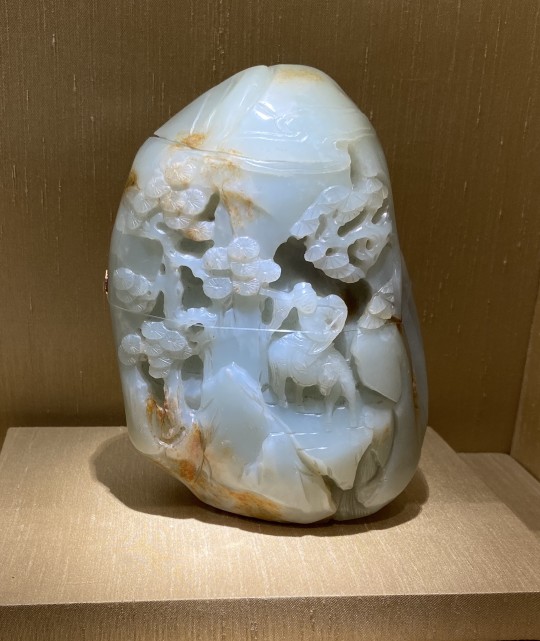
Left: Jin dynasty to Yuan dynasty (1115 - 1368) jade ornament depicting chrysanthemum flowers.
Middle left: a Ming dynasty copper daikua/带銙 (basically belt decoration) inlaid with carved jade depicting deer and pines.
Middle right: a Qing dynasty jade pendant in the shape of two badgers.
Right: Qing dynasty jadeite daigou/带钩 (basically belt buckle) with fish and bat motifs. In traditional Chinese symbolism, fish symbolizes "surplus" (鱼 is a homophone of 余), and bats symbolize "fortune" (蝠 is a homophone of 福).
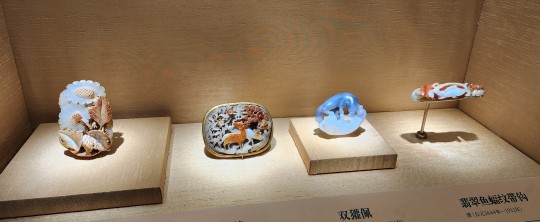
Notice how each of the above pieces utilize the colors inherent in the jade itself to lend color to the subject depicted. This method is still widely used today in modern jade/stone sculpting, and sometimes the finished piece can be stunning. Here's a modern example that's not from this exhibition: the piece 山乡晨曦 ("Mountain Village in Dawn's Light") by 黄日富. This entire scene is fashioned from a single stone.
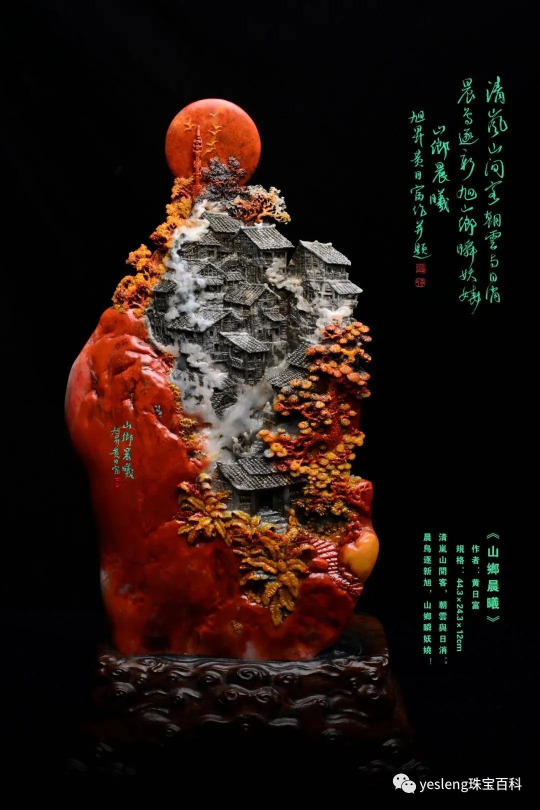
And back to the exhibition, I forgot to take pictures of the placards for the next two artifacts, and the museum's complete online catalogue doesn't have a search function (UGH)......so I'll put my best guess here, but don't take my word for it lol
A jade decor depicting a dragon, probably from either Ming or Qing dynasty:
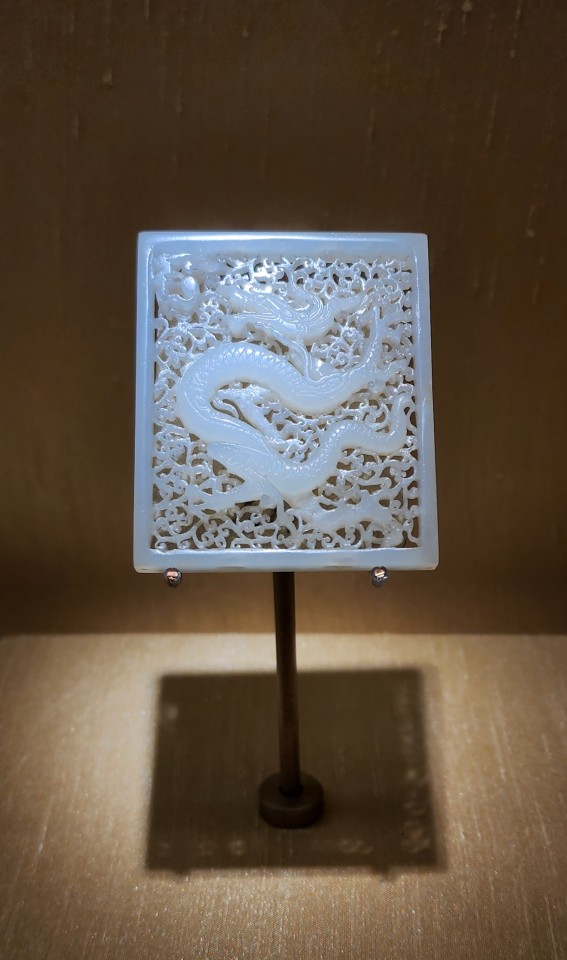
This seems to be a jade jianzhi/剑璏, no idea what time period it's from. Jianzhi are basically flat belt loops attached to the sheath of the jian sword scabbard, so that the jian sword may be carried on its owner's belt.
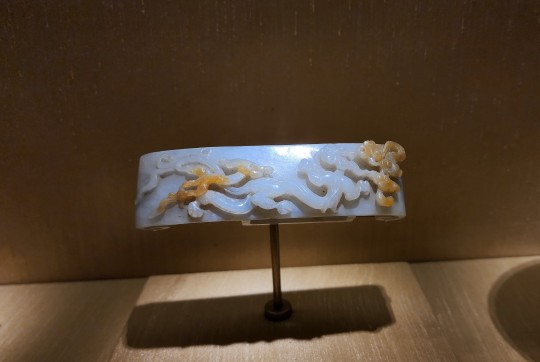
And onto The Power of Science and Technology exhibition. The pictures I'm sharing here will be primarily focused on ancient Chinese science and technology.
Ink rubbing of the famous Southern Song dynasty (1127 - 1279) star chart stele (called 天文图碑 in Chinese), showing the positions of the Chinese constellations. This star chart was drawn by Southern Song dynasty astronomer Huang Shang/黄裳 based on observations made between 1078 and 1085 (during Northern Song dynasty), and the stele was erected in 1247. The stele itself still stands in the Confucian Temple in Suzhou, China. Here's a link if anyone wants to see a clearer image of the rubbing (to avoid confusion: the rubbing in this webpage was made in Qing dynasty, but the stele was erected in 1247).
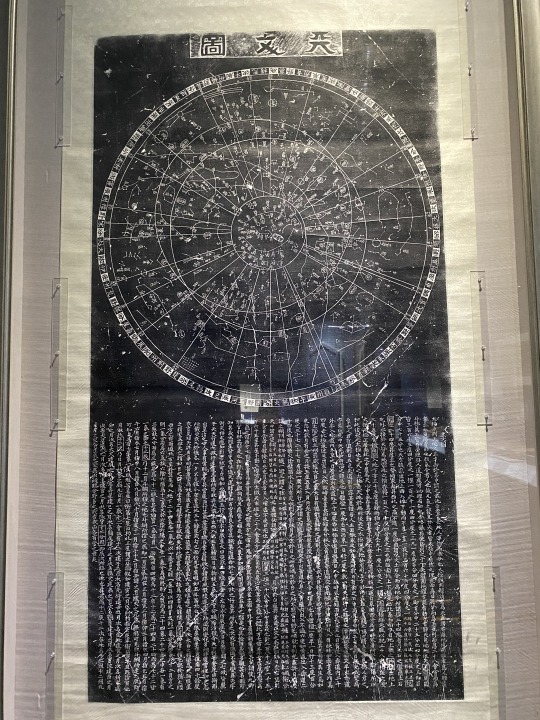
Chart of the Twenty-Eight Mansions/二十八宿 from the Ming dynasty illustrated encyclopedia Sancai Tuhui/三才图会, Volume 1. The Twenty-Eight Mansions are regions around the ecliptic used to identify the location of the Sun, Moon, Venus, Jupiter, Mercury, Mars and Saturn. This is an important concept for both traditional Chinese astrology and astronomy.
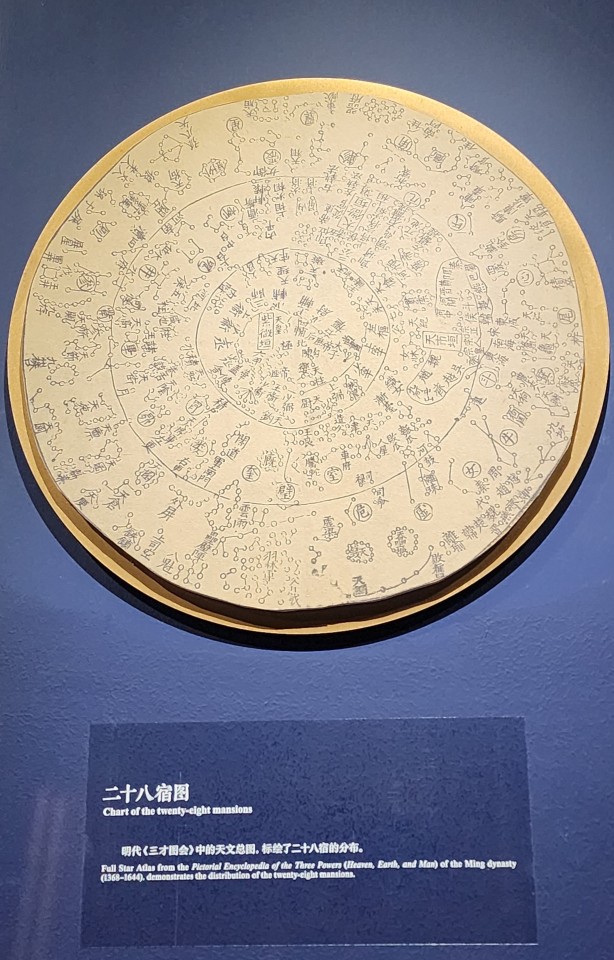
Top left: ancient observation of a solar eclipse documented in the Book of Documents/《尚书》.
Top right: ancient observation of Halley's Comet in fall of 613 BC documented in Spring and Autumn Annals/《春秋》. Apparently Chinese historical records never missed a single observation of the return of Halley's Comet from 240 BC to 1986, which is pretty amazing (note: this author may have made a mistake regarding the year of the observation recorded in Spring and Autumn Annals).
Bottom left: ancient observation of a nova documented in Book of Han/《汉书》 (completed in 111 AD).
Bottom right: ancient observation of a sunspot documented in Book of Han.
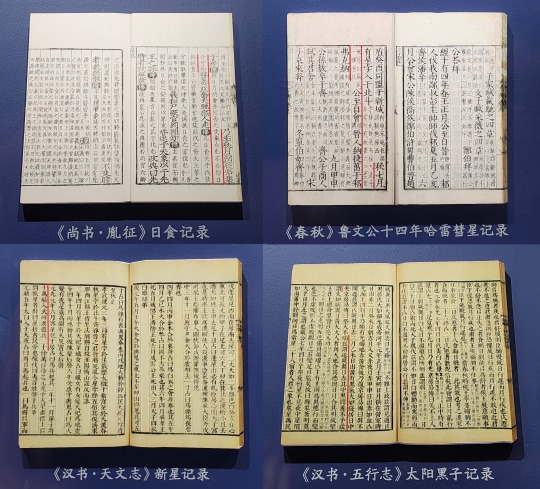
If one flips through any of the 24 official histories of China (二十四史), one will find these records of historical events peppered with observations of astronomical phenomena. This is because of the traditional Chinese astrology concept known as "interactions between heaven and mankind" (天人感应), where it's believed that whatever happens in the heavens will be reflected in the mortal realm in some way, and vice versa. Because of this indistinction between astronomy and astrology, the vast majority of Chinese dynasties would have an imperial bureau set up just to observe, record, calculate, and interpret the movement of celestial bodies and astronomical phenomena, since these were viewed as reflections of the state and fate of the entire country. In reality however, this bureau often functioned as a special panel of political advisors to the emperor. This bureau is referred to by different names throughout Chinese history, but the two most well known names are 司天监 and 钦天监.
A representation of a piece of ox scapula oracle bone from Shang dynasty (~1600 - 1046 BC; original artifact is in this museum) inscribed with terms from the Sexagenary Cycle, called Heavenly Stems and Earthly Branches (tiangandizhi/天干地支) in Chinese, or Stems and Branches (ganzhi/干支) for short. This cyclical system of 60 terms is used to record the year, month, day, and hour in traditional Chinese calendar (for example right now is still the year 甲辰, but after Chinese New Year, it will be the year 乙巳); however, in Shang dynasty, this system was only used to record days. The Sexagenary Cycle is still used by traditional Chinese painters and calligraphers when dating their works.
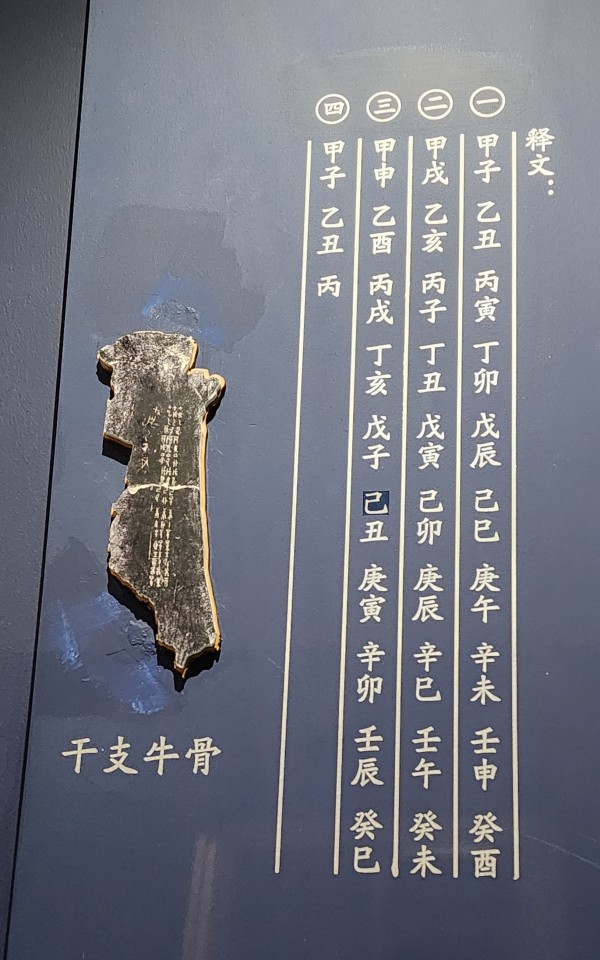
Four of the calendars used in different time periods in Chinese history, the Taichu Calendar/太初历 of Han dynasty (top left), created in 104 BC; the Daming Calendar/大明历 of Southern dynasty (top right), created in 462 AD; the Dayan Calendar/大衍历 of Tang dynasty (bottom left), created in 729 AD; and the Shoushi Calendar/授时历 of Yuan dynasty (bottom right), created in 1281. All of these are lunisolar calendars.
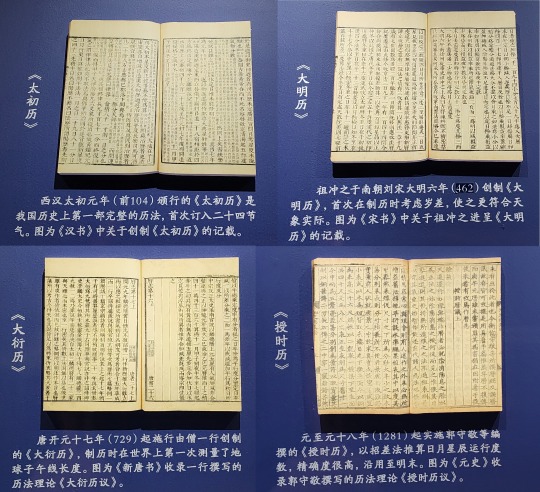
The Northern Song dynasty (960 - 1127) official military compendium Complete Essentials for the Military Classics/《武经总要》, by Zeng Gongliang/曾公亮 and Ding Du/丁度. The version seen here is the version included in the Qing dynasty book collection Complete Library of the Four Treasures/《四库全书》, completed in 1782.
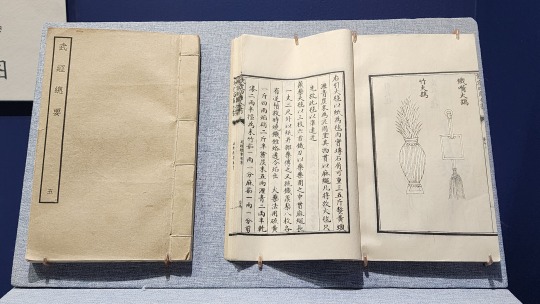
And the book that has appeared a couple times throughout this series of posts already, the Ming dynasty illustrated encyclopedia Sancai Tuhui/《三才图会》:
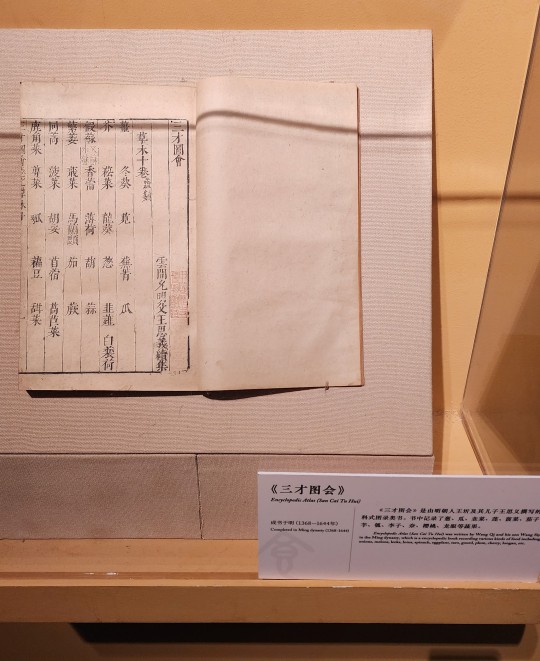
This is the Ming-era Chinese translation of the mathematical work The Elements by Euclid, titled 《几何原本》. The translators were the Jesuit missionary Matteo Ricci and Xu Guangqi/徐光启 (there's more information on the placard).
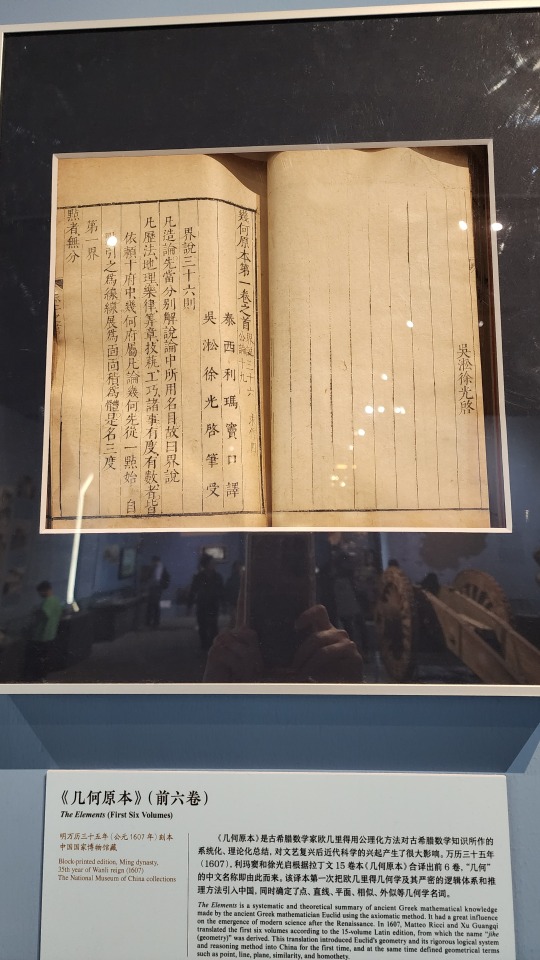
Here is one of the ways in which ancient Chinese science and technology still contributes to the world today, a lesser known example than the famous Four Inventions: the discovery of the antimalarial drug artemisinin (named qinghaosu/青蒿素 in Chinese) by Chinese chemist Tu Youyou/屠呦呦 in the 1970s. Artemisinin is derived from the plant Artemisia annua L., which was recorded in The Handbook of Prescriptions for Emergency Treatments/《肘后备急方》, a book on traditional Chinese medicine written by Ge Hong/葛洪 in 340 AD, as effective against malaria. Since its discovery, artemisinin and its derivatives have saved millions of people, and are now recommended by the WHO as part of the frontline therapy for malaria. For her discovery of artemisinin, Tu Youyou was awarded the Nobel Prize in Medicine in 2015. On display here are Tu Youyou's letter to the Chinese plant biologist Qian Yingqian/钱迎倩, and her revisions to the draft of Discovery and Development of New Antimalarial Drug Qinghaosu (Artemisinin).
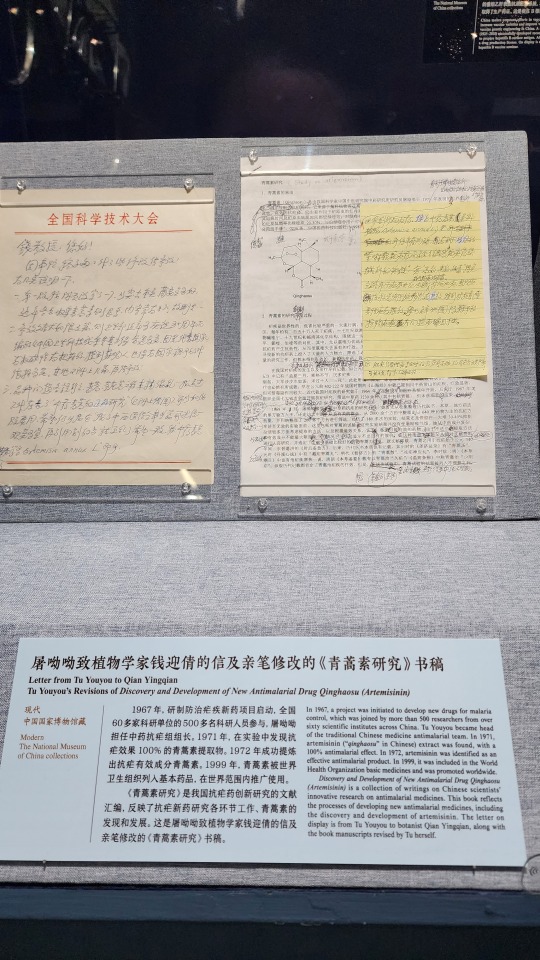
For thousands of years, Chinese people gazed at the stars in awe and wonder what messages the heavens wished to convey. Today, with modern science and technology, the heavens are not so mysterious and out-of-reach anymore, and people can appreciate the universe simply for its vast beauty. In 2013 China sent its first lunar rover, Yutu/玉兔, to the moon. In 2020, Chang'e 5/嫦娥五号 brought back a sample of lunar soil. The names of Yutu and Chang'e come from the names of the moon rabbit and the moon goddess of traditional Chinese mythology respectively (here's an old post I wrote on Chang'e and the moon rabbit, if anyone's interested in the legend).
Left: 1:1 model of the 2013 Yutu/玉兔 rover. (both pictures from National Museum of China official site; I saw the actual model and the actual sample but didn't take a picture of it)
Right: part of the lunar soil sample that Chang'e 5 brought back in 2020.
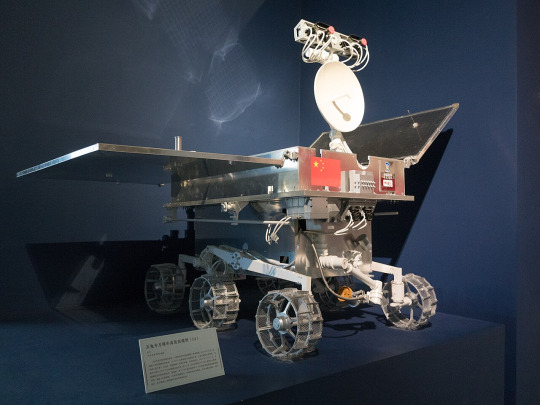

Looking at the lunar soil sample really made me appreciate how far humanity has come, and how much China has developed. I remember witnessing China's first manned spaceflight in 2003, that was just a little over 21 years ago. These are truly exciting times.
Phew. Another post that ended up being way more involved than I initially thought......the next post will be the last one of the museum posts in the 2024 China series, and it will be on the history of tea, wine, and food in China (mmm). It will be posted by the Friday before Chinese New Year. Stay tuned!
#2024 china#beijing#china#national museum of china#jade#jade sculptures#chinese art#chinese astronomy#chinese astrology#chinese calendar#chinese medicine#artemisinin#chinese culture#chinese history#art#culture#history#astronomy#astrology#medicine
97 notes
·
View notes
Text
Sing a Song of Sixpence (Joel Miller's Christmas Vacation)

Moth's Masterlist // follow @mothandpidgeon-updates and turn on notifications to stay updated with my fics!
rating: G (fluff)
summary: Sarah requests a special trip over Christmas vacation. Joel does whatever it takes to make her wishes come true.
contents: fluff, 90s nostalgia, colonial america?
wc: 1.2k
a/n: Happy holidays to my Secret Santa, @whocaresstillthelouvre! Surprise but not really. Mallory, i knew we were going to be friends when you told me how much you love Colonial Williamsburg. I couldn't believe I found someone that overlapped in so many of my little niches. So when you told me that I was your secret Santa, I knew your fic was going to be about your favorite place. Thank you for being such a great friend, supporting me and my writing, and being my stoner buddy. I hope you enjoy your gift!
Thank you @schnarfer and @moonlitbirdie for giving this a once over! Dividers by @/saradika-graphics

Sarah clutches her doll as she skips down the red brick sidewalk.
Joel hadn’t realized just how expensive a toy could be until he shelled out the $86 to buy it. Sarah had begged and begged before he gave in and got it for her. “Felicity Doll” had been on every wish list, the American Girl catalogue left open on the kitchen table for two whole years. Sarah read and re-read not only the Felicity series but Addy, Kiersten, and Samantha, too, the paperback books creased and dog eared. This was no passing fad, not a fleeting interest, and so Joel saved up and surprised her with an American Girl doll of her very own for her birthday.
She knew what was in the tall, rectangular box before she’d even unwrapped the damn thing, screeching and running around the living room in celebration. Sarah loved the doll, taking it everywhere with her, tucking it in bed beside her. Best money Joel had ever spent.
Except Felicity had a plethora of accessories and outfits, furniture and accouterments that all cost a handsome sum. More catalogues came, glossy pages with marker drawn circles around Felicity’s tea set and writing desk and pony. (“The doll has a pony?” “It’s in the books, Daddy!”) There were cookbooks and paper dolls and Sarah-sized colonial dresses that she desperately needed. It seemed that Joel was personally bankrolling the Pleasant Company.
And now he’d agreed to bring Sarah to Colonial Williamsburg. He really hadn’t had the heart to say no to her when she ask that they take a family trip there over winter break though he knew it would cost him an arm and a leg.
“Wouldn’t you rather go to Disney World?” Tommy asked.
Joel shot him a look. Disney would’ve cost three times as much but it wasn’t about the money. He was proud of his little girl for being a bookworm, choosing museums and butter churns over roller coasters and Minnie Mouse.
“It’s where Felicity’s from,” she insisted.
Sarah leads Joel by the hand down Duke of Gloucester Street. The quaint little houses are all decorated for the season– around each doorway is an evergreen garlands accented with fat, red bows. There’s a chill in the air. He hadn’t considered the weather in Virginia when he’d planned this vacation. Sarah doesn’t seem to notice, excitedly pointing out the carolers on the corner and the horse drawn carriage conveying tourists down the sandy street.
Sarah devours every little detail, listening with eyes like saucers as the interpreters dressed in old fashioned costumes drone on about milliners and beeswax candles.
Joel’s mind just keeps slipping back to the fact that he and Tommy aren’t working right now. A whole week with no income.That’s going to hurt when the credit card bill comes in.
”D’you think they ever sniped a redcoat with one of those?” Tommy asks on a tour of the Governor’s Palace, nodding towards one of the many guns hanging on the ceiling.
Sarah shushes him.
”Hey,”Joel whispers to his brother. “Remind me when we’re back at the motel, I’ve got to call and get those tiles ordered for the duplex project.”
”C’mon man. You’re thinking about work now?” Tommy complains.
”Can’t lose another day. Order it now, it’ll be waiting for us when we’re back,” Joel explains.
“Daddy! You’re not listening!” Sarah hisses.
“Sorry, babygirl,” he says, squeezing her hand in his.
He tries to pay attention, he really does. Joel’s never had much of a mind for history. Dates and places and stuffy old men. The buildings are interesting, at least. He amuses himself wondering what it would be like to build a house like they did in the olden days. A rough saw and a chisel and his bare hands. Like a pioneer on the homestead.
There’s a gift shop at the end of the tour. Of course. Joel lets out a sigh of resignation. Sarah knows better than to ask but she’s eyeing a tin whistle and a book about ghost sightings.
“Pick one,” Joel offers, hoping she goes for the book. The last thing he needs is Tommy’s yammering and the squeal of Yankee Doodle for the rest of the trip.
Her brown eyes move between the two souvenirs, lips twisted in thought.
“Shit. I’ll buy you both if your Dad’ll wear this,” Tommy says with a laugh. He’s holding up a little felt tricorn hat meant for elementary school kids.
”Really?” Sarah asks, all bright and giggling.
Joel glowers.
Dinner is a fifteen dollar hamburger at one of the historical taverns. Sarah’s doll gets its own seat at the table, a paper napkin tucked into the collar of its dress. Joel’s able to pawn the hat off on Sarah but not before Tommy got a photo on his disposable camera.
“That’s going on the fridge,” he chuckles.
As Joel pays the bill (noting the price of Tommy’s three beers), there’s a rumble of drums.
“What’s that?” Tommy asks, craning his neck towards the window.
“The militia’s coming through,” the waitress says, clearing the dish from Sarah’s ice cream sundae (the historical accuracy of which is questionable). “They’ll march in for the fireworks.”
“Fireworks!” Sarah gasps.
Joel sighs. He’s exhausted, out all day in the cold wrangling his brother and his daughter. His knees are aching and he’s ready to call it a day and go back to the motel. But Sarah is practically bouncing in her seat.
Joel bundles himself up once again and the trio join the crowd that lines the street. A fife and drum corps in their scarlet uniforms march past followed by an officer on horseback. The sun has long set and the air nips at Joel’s throat. He wishes he had a scarf, could probably pick one up in yet another gift shop but it would surely cost a small fortune. He hopes these fireworks will be over soon so he can put his feet up.
The little town looks quite festive in the night. Candles glow in every window and the street lamps cast a warm light over the tourists. A massive evergreen on the Palace Green twinkled with modern lights but it only adds to the atmosphere.
Without warning, the first firework shoots into the sky, its bang makes Tommy jump. It bursts into a shower of silver. The other spectators cheer and more fireworks follow— red and blue, green and gold.
Sarah’s gloved hand wraps around Joel’s. Her face is turned up to the sky, illuminated by the colorful fireworks. Her eyes round with wonder, sparkling pink and white from the cascade of sparks above.
She’s having the time of her life. And she deserves it. Sarah’s a good kid. Polite, studious, thoughtful. Joel’s always been proud of her though he has no idea how she turned out so sweet considering he and Tommy have been the ones that raised her. This is what it’s all for, he reminds himself. The hard work and long hours, the never ending stress of bills for things he can’t afford. It’s all for her.
She turns to find Joel watching her, his heart swollen in his chest.
“Thanks, Daddy,” she says. She squeezes his hand and pulls her doll close to her chest.
That thing was worth every penny.

Happy holidays to everyone! Special shout out to the tent pitchers and all of my moots but also to anyone that's read my fics this year. Thank you for your support.
99 notes
·
View notes
Note
Hello!
I am an aspiring author who struggles with accurately portraying historical clothing, and I stumbled across your blog while searching for photographs and information on late 19th century/USA Gilded Age fashion. From the research I've seen compiled across books/the internet, the clothing of the upper class from that area is very well documented in paintings, garment catalogues, photographs, museums, etc....but finding information on what the day-to-day wear of normal people was like is proving much more difficult. Since you seem to be knowledgeable in the subject of historical clothing in this approximate time period, I was wondering if you knew about any good resources to learn more about what people who couldn't afford to follow upper class trends were wearing in the general era as well as any general information around these items.
If it helps, I'm focused on eastern and southeastern United States farming/small railroad town/mountain mining/gulf coast wetland communities, but even just more general resources about what sort of clothing that the average poor person during the Gilded Age wore would be greatly helpful. I've been able to find a few photographs here and there, but these probably aren't an accurate depiction of a persons' 'day-to-day' wear, and I also haven't found much on how women learned to sew homemade clothes, what garments if any would have been bought, where people in rural areas would have sourced their cloth, what undergarments were like, how work shoes were made & aquired, ect.
Please feel free to ignore this if it isn't something you're interested in answering as I'm sure you get a lot of asks, but I'd greatly appreciate it if you have any pointers!
So here's the thing about 19th-century clothing:
in many ways, it's the same all the way down
now, that's a serious generalization. is a farm wife in Colorado going to be wearing the same thing as a Vanderbilt re: materials, fit, and up-to-the-minute trendiness? obviously not. but because so much of what people wore back then has only survived to the present day in our formalwear- long skirts, suits, etc. -we tend to have difficulty recognizing ordinary or "casual" clothing from that period. I also sometimes call this Ballgownification, from the tendency to label literally every pretty Victorian dress a Ball Gown (even on museum websites, at times). Even work clothing can consist of things you wouldn't expect to be work clothing- yes, they sometimes worked in skirts that are long by modern standards, or starched shirts and suspenders. Occupational "crap job clothes" existed, but sometimes we can't recognize even that because of modern conventions.
A wealthy lady wore a lot of two-piece dresses. Her maid wore a lot of two-piece dresses. The trailblazing lady doctor working at the hospital down the road from her house wore a lot of two-piece dresses. The factory worker who made the machine lace the maid used to trim her church dress wore a lot of two-piece dresses. The teenage daughter of the farm family that raised the cows that supplied the city where all those people lived wore a lot of- you get the idea. The FORMAT was very similar across most of American and British society; the variations tended to come in fabrics, trims, fit precision, and how frequently styles would be updated.
Having fewer outfits would be common the further down the social ladder you went, but people still tried to have as much underwear as possible- undergarments wicked up sweat and having clean ones every day was considered crucial for cleanliness. You also would see things changing more slowly- not at a snail's pace, but it might end up being a few years behind the sort of thing you'd see at Newport in the summer, so to speak. Underwear was easier to make oneself than precisely cut and fitted outer garments for adults (usually professionally made for all but the poorest of the poor for a long time- dressmakers and tailors catering to working-class clientele did exist), but that also began to be mass-produced sooner than outer clothing. So depending on the specific location, social status, and era, you might see that sort of thing and children's clothing homemade more often than anything else. Around the 1890s it became more common to purchase dresses and suits ready-made from catalogues like Sears-Roebuck, in the States, though it still hadn't outpaced professional tailoring and dressmaking yet. Work shoes came from dedicated cobblers, and even if you lived in isolated areas, VERY few people in the US and UK wove their own fabric. Most got it from the nearest store on trips to town, or took apart older garments they already had to hand and reused the cloth for that.
I guess the biggest thing I want to emphasize is that, to modern eyes, it can be very hard to tell who is rich and who is anywhere from upper-working-class to middling in Gilded Age photographs. Because just like nowadays a custodial worker and Kim Kardashian might both wear jeans and a t-shirt, the outfit format was the same for much of society.
Candid photography can be great for this sort of thing:

Flower-sellers in London's Covent Garden, 1877. Note that the hat on the far right woman is only a few years out-of-date; she may have gotten it new at the time or from a secondhand clothing market, which were quite popular on both sides of the Atlantic.

Also London, turn of the 20th century.

A family in Denver, Colorado, c. early 1890s.

Train passengers, Atlanta, Georgia, probably 1890s.
Hope this helps!
#ask#anon#long post#dress history#clothing history#fashion history#one of my friends once said 'most stuff made by historical costumers online isn't out of the question for a maid on her day off'#'or a middle-class wife'#and they're so right#it just ALL looks Fancy to modern eyes
105 notes
·
View notes
Note
Where do you find all of these pictures and catalogues?









Libraries! and Museums! with robust online collections! One resource can lead to other resources because some of these links are systems of interconnected libraries. Most provide high-resolution downloads and transcribed text. I include links to all of my sources in their respective posts.
Bibliothèque Nationale de France et al (Gallica)
Ville de Paris / Bibliothèque Forney et al
Rijksmuseum, Netherlands
Los Angeles Public Library
Les Musées de la Ville de Paris
Cooper Hewitt, Smithsonian Design Museum
Digital Public Library of America
Internet Archive
The Met Costume Institute Fashion Plates
63 notes
·
View notes
Text

In Greeting and Introduction:
In 1986, Pleasant Company unleashed the American Girls upon the world, and nothing has ever been the same. If you’re between the ages of 25 and 40 (sorry, Gen Z, but this is really a millennial phenomenon) and were at any point in your childhood aligned or identified as a ‘girl’, you probably have memories of decadently arranged extra-wide catalogues coming in the mail, or slim box sets of six books with names like Samantha Learns a Lesson or Changes for Kirsten, or visits to a toy store that was more like a luxury hotel, or – if you were especially lucky – unwrapping a long and heavy box on your birthday or on Christmas to reveal a much-anticipated new best friend. Even if you weren’t subjected to the rigors of late-twentieth-century girlhood, you probably knew something about this brand thanks to the way it took hold in the hearts and minds of an entire generation of – ha! – American girls who went to school with other American children and often brought dolls and books and catalogues and trip reports back with them.
So, what exactly was this brand?
1986 is a fascinating year in pop culture, and one I’ve been personally fixated on for over a decade. It’s the year of the (first) death of Optimus Prime in The Transformers: The Movie, the year of Star Trek IV: The Voyage Home, the year of Phantom of the Opera’s spectacular West End debut, the year of Labyrinth, the year of Hellraiser. If you outgrew American Girl and trended toward the weird and darkly gothic, this is a year you’re intimately familiar with, whether you know it or not. Fitting, then, that it’s the year the dolls were born.
The story goes that educator Pleasant Rowland, in the process of attempting to buy dolls for her family, found herself frustrated by a perceived gap in the market. While baby dolls served as proxies for burgeoning parental instinct, and fashion dolls served as more mature aspirational figures (or, in many cases, adult stars of complicated child-crafted soap operas), there were no dolls that girls could look upon as peers. I find myself skeptical of this claim, largely because mythical doll origins are often hilariously selective and inaccurate – for one thing, Barbie was not even close to the first adolescent/adult fashion doll for little girls – but it is consistently cited as one of the concerns in developing the line. With that frustration to chew on, and inspired by a visit to Colonial Williamsburg (a living history museum focused on life in America in the immediate years preceding the Revolutionary War), Rowland developed the concept of the American Girls. These would be eighteen-inch cloth and vinyl dolls portraying distinct historical figures living in different eras of American history, each with their own name and family and backstory. She worked with author Valerie Tripp to develop the identities of each girl, and then launched the brand under her new company, Pleasant Company (which is such a clever idea for an instantly recognizable corporation) with three dolls ready to go.
Now, there are American Girl stores in multiple malls, and when I was a little girl there were near-mythical American Girl Places in Chicago and New York and I think somewhere in California, but when Rowland began her business model was entirely by mail with no brick-and-mortar location to visit. Little girls and their families became aware of the existence of these dolls and their stories when catalogues that quickly became iconic arrived in the mail once every few months, and despite the high prices of everything from the dolls themselves to the books telling their stories, they bought up everything Pleasant Company had to sell. Rowland had a bona fide hit on her hands.
She had launched the brand with three characters – Kirsten Larson, a Swedish immigrant and pioneer living in the Minnesota Territory in 1854, Samantha Parkington, an Edwardian girl from a rich family living in New York in 1904, and Molly McIntyre, a Scottish-descended girl from a solidly middle-class family living in Jefferson, Illinois in 1944. Each doll, when ordered, came with a book bearing their name, and there were two additional books available for purchase alongside the collections of themed accessories and furniture. This number quickly expanded to six, all bearing similar names and reflecting similar themes across multiple decades. In 1991, a fourth historical character joined the lineup – this was Felicity Merriman, a gentleman’s daughter from 1774 Williamsburg. After her was Addy Walker, introduced in 1993, a fugitive slave who escaped to Philadelphia with her mother and lived there in 1864. Next in 1997 came Josefina Montoya, a rancher’s daughter living near Santa Fe, New Mexico in 1824 with her father, sisters, and extended family. In 2000, Kit Kittredge of 1933’s Cincinnati, Ohio joined the lineup. And lastly, at least for this analysis of my own history with the brand, in 2002 we have my dearly beloved Kaya’aton’my of the Nez Perce, living with her tribe in pre-contact years in 1764.
There are other American Girls. Mattel bought out Pleasant Company and has slowly been hollowing out the brand’s credibility, but it persists. Other historical dolls have been introduced, and many of them sound just as brilliant as the ones I grew up with. But those eight, those “original” eight, were my American Girls, and it’s their stories I want to examine, and their impacts upon my life that are still felt. Kit’s resourcefulness and adaptability when her father lost her job helped me when I was twelve and my father lost his job, Felicity’s determination to find the right balance between gender nonconformity and gender conformity inspired me to never settle for being forced into a box I didn’t fit, Samantha’s fierce loyalty to her friend Nellie was a balm to my prepubescent closeted lesbianism, and Kaya’s connection to her tribe and their traditions and culture gave me something to cling to in the midst of my rootless, forcibly assimilated indigenous childhood. (Yes, I’m indigenous, no, I’m not really going to be making my writing and blogging about an #ownvoices kind of thing, because we should get to be nerds and have the same access to privacy that white people have, but it’s relevant here and it’s relevant in my original fiction because it’s part of me.)
Of course, growing up and getting an education means looking at your past again with a wiser, more critical eye. Historical education has changed a lot since 2002, and has changed even more since 1986. The stories of the American Girls are both narrative and informative, intended to capture realistic-feeling moments in time that are grounded in real historical events and practices. How do they hold up to the standards of 2024, nearly two decades since I grew into Brontë and McCaffrey and Hugo and Dumas and Homer? How do they feel to me as an actively reconnecting indigenous lesbian whose perspective on America is very different now than when I was a child and my family tried hard to pretend we fit in? Are their books and wider stories even any good?
These are the questions I’m seeking to answer in this series of blogs, which I’ll be calling The American Girls and Me. Each fortnight (that’s every two weeks) I’ll examine a different girl, starting with her main books and going forward from there. The first series of book blogs will be published simultaneously here and on my Patreon page, completely free to read and open to the public. After that, Patreon will get things a week before they’re published here, but I’m not looking to make a serious income, so if you pay me the exorbitant price of $1 you will get to see things whenever they’re posted or you can wait for seven days to catch up. There will be some Patreon-exclusive bonus content once every couple of months, though, plus when I start publishing my original fiction it will be there alongside here, so if that sounds interesting maybe consider giving me a click?
My cutoff year is 2005 – that was the last year I asked for and received an American Girl doll as a present from my grandmother, and that was the symbolic end of the American Girl era of my life. I may take a look at the two American Girl movies that came out in 2006 and 2008 and adapted the stories of Molly and Kit respectively, but I didn’t go to great lengths to watch either of them. I was too busy rewatching The Curse of the Black Pearl and Van Helsing and The Revenge of the Sith to care about people who were now three and four years younger than me, and my own visions of both girls’ lives were too precious to me to risk a bad or disappointing adaptation.
Okay, then, what exactly will I be covering?
Like I said above, I’ll start with the stories. All eight girls, all six books + their “Looking Back/A Peek Into the Past” chapters. I’ll talk about my childhood impressions, my connections with different narratives, how those have changed now that I’m in my thirties, and places where I think the books have aged particularly poorly or particularly well.
After that, we’ll look at their short stories pre-2005, and see what those add to or detract from the canon of core story beats. These were in some cases published over a decade after the books finished up, and the tonal or thematic differences should be interesting to note.
Once the fiction is finished up we’ll look at each doll. I’ll talk about my experiences with the ones I personally own, and examine their accessories and artifacts in-person, and if it’s a doll I don’t own we’ll be looking at the catalogues from 1998-2002, which can safely be considered something of a golden age for the brand. That’s how I experienced several of the dolls, and therefore that’s what I’ll be revisiting
Next, I’ll be taking a look at nonfiction books – each of the original eight girls got a Welcome to [Name]’s World book issued for their era in American history, taking the nonfiction historical context chapters and fleshing them out to give more detail and explain more about how the lives of our girls fit into the story of the country as a whole. These are apparently extremely high-quality for children’s history books, and while I never had them as a child I definitely want them now.
Finally, having finished up books entirely, we move on to crafts and ephemera. Each girl got a paper doll set, and most of them also received a craft book and cook book. There were theater kits for pretend play as well, but I’ll be excluding those for purely practical reasons – they’re often the hardest to find, and I was never interested in that kind of pretend play with these girls.
This will be a long, involved, organized blogging project unlike anything I’ve ever really done before, but I think it will be a rewarding one. These girls are like my sisters, even those with wildly different life experiences than my own. They were a fundamental part of my childhood. They deserve to be remembered and discussed, and this era in my life deserves to be loved.
After all, I, too, was once an American girl.
#american girl#american girl dolls#felicity merriman#josefina montoya#kirsten larson#addy walker#samantha parkington#kit kittredge#molly mcintyre#kaya’aton’my
25 notes
·
View notes
Note
Hiii, I love your page and you helped so much with research. I am doing a project for my costume course, I have to design costumes from 1895, 1894 and 1896 are kinda accettable, but I having problems with creating the moodboard for every outfit. I really can't find photos or archival pieces for men, especially a character who is supposed be a 17 years old and I can't really find photos/illustrations of children nightwear (boys). I know by heart every archive of every museum and I even looked on internet archive at old magazines, but still I can't find much. Do you have any niche sources that you would recommend? Sorry to bother you, just a student losing her mind
Thank you so much! And sorry for the wait! I hope you're course is not over already and I'm late with the answer :')
17 years old boy would be already dressing in basically same clothing as men. With nightwear it's also pretty easy, since all people wore basically the same nightgowns, only details would vary. Here's an 1874 example of children's nightgowns, which are long white dresses gathered at the neckline, with long sleeves and often a bit of collar. This is the basic shape everyone wore. They tended to be more simple for children and men. Women, especially rich women, might have some more decorations. Night chemise was also an option for women. It's what it sounds like and shaped exactly like a chemise, with just maybe some differences in details.

Men and boy's nightgowns were usually called nightshirts and while they were mostly the same as women's nightgowns, they were usually a bit shorter by 1890s, usually covering just the knees. Here's an add for children's undergarment with a nightshirt for boys too from 1878.

As for adult men's nightshirts, here's first a 1891 ad with unfortunately quite poor illustration of a man's nightshirt, but if does show the popular style for men, turned down lapels. Here's another example of that style in form of an extant garment form 1900s.


By 1890s pyjamas - shirt and trouser combo - had become fashionable nightwear for men, though nightshirt were still used well into 20th century. Here's an add from 1901 showing both nightshirts and pyjamas. Pymajamas were also used as fashionable evening negligee and while in 1890s nightshirts were still usually white, pyjamas were not and often had a pattern.

Underwear and nightwear are types of clothing that rarely survive history, since they are usually not fancy so they are not preserved diligently and are worn close to skin therefore quite quickly are worn down. That's why ads (in periods when they started to become a thing) are great sources for those kinds of garments. The last add is from a catalogue for mail-order clothes. These are usually excellent sources for the basics, like underwear and nightwear, which were already sold as ready-made garments in stores and by mail-order businesses by 1890s. Internet archive has several digitized fashion catalogues from around the time you are looking for so I suggest looking through them if you want to find more specific examples. This was really the first that came across me that was close enough. Some libraries also have excellent digital collections of old ads, like the New York Public Library (from where the other above ads are from), so their collections are also worth going through.
Hope this helps and I hope this is not too late for your course project!
#historical fashion#fashion history#dress history#victorian fashion#history#answers#nightwear#primary sources#historical ads#historical men's fashion
35 notes
·
View notes
Text

Ramesses Girdle
Originally described as a ‘linen belt’ but since at least 1913 it has been called the ‘Ramesses Girdle’. Paintings of Ramesses III show him wearing similar long lengths of cloth wrapped several times around the chest in a herringbone fashion, like a girdle, before being fastened around the waist.
Cartouches of Ramesses III were inscribed in ink on two faces of the plain linen at one end but this is now almost completely destroyed (Stobart’s 1855 catalogue has a copy of the text as it was when in his possession).
The girdle is woven from linen and decorated with rows of ankh signs, a hieroglyph used to write the word for ‘life’. As a piece of clothing it provided upper body support and encircled the pharaoh with life-giving protection in the battlefield.
It measures 5.2 metres in length and tapers from 127 to 48 mm in width. This tapering is achieved by taking out bunches of unbleached threads from the centre at regular intervals and ensuring that the warp ends per cm remain the same.
New Kingdom, 20th Dynasty, ca. 1186-1155 BC. Now in the World Museum, National Museums Liverpool. M11156
Read more
28 notes
·
View notes
Text
The Brooch of the Dragon

By Adrián Maldonado
The gift and the curse of being a medievalist is that watching fantasy fiction adaptations can feel a bit like taking your job home with you. You’re still able to be a fan, but you’re also hyper-aware of the real-world inspirations for settings, props and storylines. You’re at an elevated risk of taking to social media and posting about it.
Despite being set in the ancient past of Westeros, I never really get the sense of HBO’s House of the Dragon series as a particularly archaeological story. Sure, there’s occasional ruins like Harrenhal, and some ancient artefacts, but otherwise there’s very little of that sense of the past irrupting into the present that we associate with archaeology.
But then in Season 2, right from the first episode, one aspect of HotD jumped out to me, and it seems like it was just me. There was a real, shocking intrusion of real-world archaeology into this fictional past.

A shocking intrusion (source)
Episode 1 opens up north at the Wall, where two of the realm’s young lords, Cregan Stark and Jacaerys Velaryon, inspect the Night’s Watch. Cregan’s costume and accent ring all sorts of nostalgia bells for fans of the antecedent Game of Thrones series. Jacaerys (or Jace for short) is less awesomely attired, but his woolly black cloak is pinned across his chest with a striking ring-shaped brooch.
And I thought, hey, I know you.
Since last I wrote on these pages, I have become a museum nerd, and have written a book on Viking Age artefacts in Scotland. This involved poring over museum catalogues and excavation reports to become fluent in the visual language of early medieval Europe. There’s lots of ways to be an archaeologist, as covered in nerdy detail on these pages, but dammit, nothing beats the thrill of studying an artefact made, worn and loved a thousand years ago.
And every once in a great while, you get artefacts that reach out from beyond their museum cases and sneak into the zeitgeist. The Lewis Chessmen pop up in Hogwarts; the Sutton Hoo helmet gets everywhere. But I’m declaring the 2020s the age of the pop culture penannular brooch.
Introducing the penannular brooch

Aldclune, Perthshire penannular brooch, National Museums Scotland
Back in the first millennium AD, in the lands which would become Scotland, Ireland and Wales, anyone who was anyone wore a brooch in the shape of an open ring, fitted with a loose pin which speared through the cloth. Twist the hoop, and the pin anchors the fabric in place: a simple but ingenious way of fastening a cloak.
I often see these described as ‘Celtic’ brooches, but in the world of costume jewellery, it seems you can call anything ‘Celtic’ as long as you throw some interlace or knotwork decoration on it. We’re better off calling them by their name: penannular brooches, defined by hoops with a gap, hence pen-, or almost, annular.
In Roman and Iron Age Britain, these were mainly small and utilitarian [Editor's note: after this was posted, I spotted a Roman penannular brooch as worn by General Acacius, as played by Pedro Pascal, in Gladiator II], but by the early medieval period (c AD 400-1100), penannular brooches had grown into big silver jobs with enlarged and ornate terminals. A cloak pinned with one these bad boys was the business suit of its day, with the slight difference that instead of just buying one, you had to earn it, and only a restricted few had access to the best craftspeople. The moulds for casting these metal brooches are found almost exclusively at royal fortresses.
These brooches remained fashionable for centuries, evolving all along the way. One of the most dramatic left-turns in the penannular brooch journey came at the start of the Viking Age. In Scandinavia, the most elaborate brooches had mainly been for women. But when Scandinavians came raiding to the Insular world of Britain and Ireland, they saw both men and women wearing these distinctive ring-shaped brooches, and they wanted them. Bad.

Ball-type silver brooch from the Skaill Hoard, Orkney, National Museums Scotland
The result is that the archaeological record for these centuries is suddenly awash with brooches: looted brooches found in viking graves, as well as hoards of brooches stashed away so vikings wouldn’t get them. By the end of the ninth century, new kinds of penannular brooches began to be made in Scandinavia. This new generation of Insular-Scandinavian brooches grew larger, sometimes to ludicrous sizes, to suit the lavish taste of these new-money overlords.
And then, a thousand years later, after a long day of not finishing papers about brooches that I’m terribly late on, I sit down on the couch to chill with some HotD, and out pops Jacaerys, wearing my homework across his chest.
Casting fantasy jewellery

Superman Targaryen (source)
It was a few years ago I started noticing the return of penannular brooches to a wider consciousness mainly through the fantasy genre. My nerdier friends were chatting about the Netflix adaptation of The Witcher. I didn’t know anything about the books, I just knew the lead guy was the actor then playing Superman in films which I also didn’t care for, but now with a long platinum wig that made him look like the Vampire Lestat on a high-protein diet.
Despite having no knowledge or interest in the series, my eye caught on a weird feature of Lead Guy’s sword. Why did Superman Targaryen have what looked for all the world like the 9th-century Snåsa brooch glued to his sword hilt?

Insular brooch from Snåsa, Nord-Trøndelag, Oslo Kulturhistorisk Museum
Apparently, the script called for Medieval Point Break to carry the brooch of someone he kills in the first episode (I couldn’t be bothered getting into it, but I think there’s answers here). The prop department chose a real archaeological artefact, a ‘Celtic’ brooch from a Viking woman’s grave in Norway, to play the part of a medieval-ish fantasy-looking jewel. Which is odd because the big, yellow brooch makes it look like he’s got a big smiley emoji following him around. But hey, it made me look.
The thing about fantasy adaptations is that they have to feel ‘right’, and that usually entails feeling vaguely medieval. So you tell your costume designer to scout for something a bit different – something that will feel medieval but less familiar, even a bit strange. They go to museums and ‘audition’ all sorts of ancient accessories, and it's often the early medieval period that gets the part. Torturing this metaphor then allows me to make a genius pun about ‘casting’ penannular brooches in prestige fantasy adaptations, for which YOU ARE WELCOME.

The Northman: authenticity Olympics (source)
2022 was basically the penannular brooch singularity. The Viking-age historical fiction film The Northman came out that year, and the press around it was that this was basically the authenticity Olympics, with a tidal wave of interviews on all the research and experts they used to build their period-specific costumes and sets. To my delight, there were tons of penannular brooches to ogle in the film (which is all good until you get to Iceland where they mainly used pins instead of brooches, but I’ll let it go this time).

Our guy Arondir
Then the streaming wars escalated to the level of Rings of Power on Amazon Prime. In season 1, they introduced us to both Baby Elrond and my guy Arondir wearing ‘Celtic’-inspired penannular brooches, recognizable in form but pleasingly Tolkienesque in design.
And so we come to HotD. For season 2, new costume designer Caroline McCall dutifully searched for archaeological inspiration.
“I like costumes to feel like clothes and not costumes that the actors have to wear when they become the characters. So I started looking at ancient civilizations, medieval dress and how the clothes could be constructed so that everything felt real in the time period.” - Caroline McCall
To do so, she visited the British Museum, and came up with objects which combined early medieval “Celtic”, Roman and Viking styles, but still fit in with the kinds of jewellery used in season 1, and the visual world of Westeros as established across 8 seasons of Game of Thrones. Brooches fit the bill, and specifically, penannular ones. One of the first we see in the first episode of season 2 was Jacaerys’s brooch.
If it was just that one thing, it would hardly be enough to write home about, much less come back and revive this blog for. But then I spotted another, and another. The whole rest of the season, I went all Leo DiCaprio pointing meme as they kept popping up (it’s a sickness). Season 2 of HotD was a brooch bonanza. So to share my trauma with you, here’s my guide to the real-world artefacts they seem to be inspired by. Fair warning – I’m so late in actually writing this that I feel no compunction in sharing spoilers for HotD seasons 1 and 2.
The Blackwoods and the Brackens
In HotD season 2, episode three, we are introduced to some new faces who, we quickly gather from context, are members of the feuding houses of Blackwood and Bracken. They wear different colour clothing to help us tell them apart, but, as if to communicate how they are more alike than they are different, the leaders of both parties wear very similar penannular brooches.

This guy, who the google machine tells me is named Davos Blackwood, wears a silver penannular with elaborate circular terminals, and weirdly, what looks like a bronze pin. I don’t know of any brooches which mix metal components in this way, but silver brooches with disc-shaped terminals are fairly common down to the ninth century. They were particularly popular among the Picts, the real-life ‘kings in the north’ in what would become Scotland.

Carronbridge, Dumfriesshire penannular brooch, Dumfries Museum
At first glance, it looked like the brooch terminals were perforated, which seemed peculiar, but on closer inspection, it looks like they have empty settings. Well, lots of these brooches in museums also have empty settings, but it’s not on purpose – it’s because they are quite old and the glass, amber or garnet insets have fallen out!

The Blackwoods’ rivals in this scene are the Brackens, led here by a guy called [checks google] Aeron Bracken, who also wears a penannular brooch. His looks a bit different, though. It appears to be made from a copper-alloy rather than silver, suggesting the Brackens are maybe a rung lower down the social ladder. He wears it slightly differently as well, with the terminals facing in toward his chest rather than straight up. More likely to impale yourself, I might add, which may have historically affected their family’s standing, but I digress.

Brooch from the St Ninian's Isle, Shetland hoard, National Museums Scotland
Now, this brooch looks rather like some of my absolute favourite Pictish brooches, with confronted animals. Most of these were also made of bronze, but often with an outer layer of gold, silver or even tin to mask their true colour. These were never terribly common, but they were, however, a type that vikings took a shine to, and so from Ireland to Sweden, we start to see lots of pretty awesome takes on penannular brooches with beast heads.
But for all that, I think the artefacts that the Bracken brooch remind me of most is these ancient Greek ram’s head armlets. They do have examples in the British Museum, too, where we know the inspo came, so for all my digression, this may have been the ultimate inspiration.
Jace and Baela

The other most prominent ring-brooches in HotD season 2 are the ones worn by the putative future royal couple, the heirs apparent of Team Black (if they survive the next season), Jacaerys Velaryon and Baela Targaryen. These get a lot of screen time from various angles, so we have a better idea of what these look like (and for the keen-eyed, how they play against different lighting and fabric).
We have already seen Jace’s brooch, somewhat lost in the black gloom of his northern cloak in episode 1. As the season goes on, we see his outfit and demeanour change from princeling to general, with his brooch becoming ever more prominent, announcing his station almost like a miniature crown.


Brooch from Høm, Zealand, Copenhagen Nationalmuseet
As Jace’s brooch becomes clearer, we see the hoop is of twisted silver, with what look like dragon-head terminals and a mask at the head of the pin. It’s a mashup of lots of things, but is essentially again a Viking-age take on a penannular brooch. Like the Brackens’ brooch, the hoop ends with confronted heads, but adding a mask at the head of the pin seems to be a Scandinavian Borre-style development. The twisted hoop is drawn from Gotlandic brooches of a similar vintage. All the faceted surfaces allow the light to play across it more dynamically, making it seem to almost move or come alive.

But then turning to Baela we get a rather different take. She wears a matching padded surcoat to Jace’s but her brooch is clearly different. To start off with, it’s not penannular but annular – a full ring. That means it looks great, but can’t work as a fastener in the same way, as it can’t anchor the cloth with its hoop. This is perhaps why Baela’s is worn with an awesome silver retaining chain, fastened to her belt.

Tara Brooch, National Museum of Ireland
There are early medieval parallels to the use of a retaining chain. In eighth-century Ireland, there was a fashion for brooches that looked like penannulars, but with such elaborate ornament across the terminals that they were no longer terribly functional without a bit of help; the Tara Brooch is the best example.

There’s good reasons why Baela’s brooch is different. It expresses continuity with the existing Game of Thrones adaptation's visual language, as her ring brooch with dragons recalls the brooches worn by Danaerys Targaryen and her retinue, Missandei and Grey Worm, towards the end of the series. As arguably the only legitimate heir to the throne between her and cousin Jace, it is fitting to draw a line from Baela to the future queen.
But all this brings us back to Jace’s brooch which, while functional, actually seems to become less and less practical and more symbolic as the season goes on. Once he acquires his forever outfit of a studded surcoat with fetching red capelet, the brooch worn at the shoulder is no longer actually doing anything. It is pinned onto the cape with its pin pointing down the gap in the terminals, worryingly aimed at his heart. As one Reddit user pointed out, his brooch becomes something rather like the Hand of the King pin (for which, see more below). His brooch, now part of his uniform, is acting like a general’s medals.

One final interesting point on the brooches of Team Black. By the end of the season, we have recruited a few new team members. At least one of them gains a dragon-brooch, and it is a doozy. It’s an annular dragon similar to Baela’s, but supercharged. New converts are the biggest zealots, and Ulf may be compensating for quite a lot – I guess we’ll find out next season.
Penannular power: the Hand of the King
Gathering all of the observations above, then, it seems that Westeros is currently in a historical phase akin to Scotland and Ireland in the Viking Age. Penannular brooches seem to have been widely used, but are now becoming the preserve of regional lords. At the same time, in the halls of power, there are exaggerated versions of penannular brooches being made, but they are less and less functional, and more totemic, retaining the traditional symbolism of power, but worn as medals and badges.

Hand of the King pin as used in House of the Dragon (source)
There is one last example that convinces me that the use of penannular brooches in HotD is more than just eye candy. It takes a real sickness to even notice this, but there was a subtle change to the design of the iconic pin that the Hand of the King wears in House of the Dragon. In the Game of Thrones series, the pin was a simple hoop and hand, but the subtle redesign for HotD made me do a spit-take.

Penannular brooch from Ireland, Walters Art Museum
The design is obvious to anyone who has spent too long looking at museum catalogues: the hand is now encircled by the early Irish bronze penannular brooch from the Walters Art Museum in Baltimore.
If we assume that penannular brooches ‘evolved’ in a similar way in Westeros as they did in Britain and Ireland, the kind of brooch used on the Hand pin would be an antique – the Walters Museum brooch is a classic Kilbride-Jones “group C” of the sixth or seventh century, or some 200-300 years older than the Pictish examples highlighted above.
I love the HotD Hand of the King pin as the apotheosis of the penannular brooch in Westeros. While there still are apparently lots of them out there among the petty kingdoms of the Riverlands, among the halls of power we see that big silver brooches were already on their way to becoming symbolic, keeping their ring shape only as a nod to the antiquity of the brooch as a badge of power. From the annular brooches of Team Black to the antique brooch depicted on the Hand of the King pin, Season 2 of HotD is a great example of how early medieval material culture actually worked, and continues to work on us now, however imperceptibly, more than a thousand years later.
AlmostArch is no longer on Twitter. Follow us instead at AlmostArch.bsky.social.
Featured image by siilverlady
#House of the Dragon#HotD#Rings of Power#the witcher#the northman#penannular brooches#archaeology#early medieval#Picts#Scotland#gladiator 2
7 notes
·
View notes
Text
















The Imperial Style: Fashions of the Hapsburg Era
Intr.by Diana Vreeland
The Metropolitan Museum of Art New York 1979, 168 pages, 22,5x28,5cm, ISBN 0-87099-232-5
euro 50,00
email if you want to buy [email protected]
This is the book based on the hugely successful exhibition Fashions of the Hapsburg Era: Austria-Hungary, held at The Metropolitan Museum of Art from December 1979 through August 1980. The show presented more than 150 costumes, uniforms, and military and equestrian trappings dating from the eighteenth century in Austria and Hungary to the collapse of the Hapsburg Empire in 1918. But at the heart of the exhibition were the costumes and liveries worn at court in the late nineteenth century, during the reign of Emperor Franz Joseph I and Empress Elisabeth—one of the most highly romantic periods in European history. At mid-century the power of the empire was already waning, but the grandeur of the costumes, the vestments of the civil orders, and the gala gowns of the ladies of the court belied the aura of impending ruin.
The subdued glamour of the Austrian clothes contrasts sharply with the oriental richness of the Hungarian costumes, which show the degree to which the Magyars bore the weight and the cultural influence of the Turks, who besieged their borders for centuries. The Hungarian court costumes are resplendent with fur and encrusted with jewels; the women's court trains are heavy with embroidered gold.
All the pomp and ostentation of the era are conveyed in the present book, which also contains much more than a record of the exhibition. Ten esteemed authors, experts in their fields, trace the evolution of style in Vienna and Budapest—from the long reign of Empress Maria Theresa, who worked tirelessly to promote a stable fashion industry in Vienna, to the Congress of Vienna and the elegant simplicity of the Biedermeier period and then the climactic reign of Franz Joseph I, which culminated in his coronation as king of Hungary in 1867. The book is a splendid document of a time much misunderstood and never matched for sheer dizzying romanticism.
Each essay is lavishly illustrated in color and black and white, with eighteen specially commissioned color plates of costumes and accouterments in the exhibition. A detailed chronology of the years between 1699 and 1918 and a selected bibliography are included.
07/12/24
#Imperial Style#Hapsburg Era#Metropolitan Museum of Art#fashion exhibition catalogue#Met NY 1979-80#Austria & Hungary#costumes#uniforms#military trapping#equestrian trapping#Empress Maria Theresa#Gustav Klimt#fashion books#fashionbooksmilano
8 notes
·
View notes
Text
























Die Gewerbe der Mode in Venedig
vom 13.bis zum 18.Jahrhundert
Gestaltung : Doretta Davanzo Poli, Texte Giandomenico Romanelli, Paolo Selmi, Giovanni Scarabello, Giovanni Mariacher, Grazietta Butazzi, Michela Dal Borgo, Alessandra Sambo, Stefania Moronato, Dmenico Micconi, Doretta Davanzo Poli
1994, 127 pages, 29x24cm,
euro 40,00
email if you want to buy [email protected]
Museum Martin-Gropius -Bau Berlin Oktober -November 1994 mit aktiver Hilfe des Museo Correr, Venedig
16/02/25
#Moda a Venezia#dal XIII al XVIII secolo#Doretta Davanzo Poli#fashion exhibition catalogue#Museum Martin-Gropius-Bau Berlin 1994#Museo Correr Venezia#fashion books#fashionbooksmilano
1 note
·
View note
Note
I’m so sorry if you’ve already answered this somewhere, but how do you design your characters?
I’ve been trying to make an OC from the prohibition era and it turns out there’s basically nothing to work with for men’s outfits, so I’m curious how you made this many that look unique and fitting to the characters
There is so much to work with, though! You will tend to find more of a focus on variety in women's fashion, but there is still quite a lot of menswear to ogle too. I suppose it's just a matter of searching out ideas and inspiration in the rights corners. Here are a few suggestions:
Old Clothing Catalogues -
Collections from Sears-Roebuck and other popular clothing retailers are pretty easy to find compiled into relatively inexpensive books, or just floating online.

A fair bit of it is in the public domain now.
--Here's an entire 1922 catalogue of stuff to flip through.
-----------------
Contemporary Artwork -
Some phenomenal illustrators were working in this field amidst the "Golden Age of Illustration" and featured prominently on the covers of magazines and on the ads inside. There was a lot of emphasis on fashion.

Collier's and The Saturday Evening Post are a couple of the more prominent and easily searchable resources. The costuming on the cover art always has a lot of personality.

There's Rockwell, of course, and it's almost impossible to go wrong with J. C. Leyendecker. He's probably best known for his Arrow Collar ad art, but even his sock ads are like…

There were numerous other amazing and influential illustrators working at the time too. Here's a list of some of them. Here's a bonus Henry Raleigh featuring some of his fabulously-dressed people.

-----------------
Blogs and Articles -
There are so many of them! If you want historical accuracy, be wary of write-ups pulling all of their references from film and television. There's nothing wrong with using those for inspiration if you aren't too concerned with historicity, but there are some pretty comprehensive and well-researched things out there with more of an eye on actual fashion history too:
--Gentleman's Gazette - What Men Really Wore in the 1920s
--The Fashionisto - 1920s Men's Fashion
-----------------
Digital Collections -
There are numerous digital historic image collections stemming from universities, museums, libraries, and the government that are free to peruse too.
--The Metropolitan Museum has a searchable catalog of exhibits that includes fashion and photos
--Here's some things from the New York Public Library
-----------------
Photos at Large -
If you aren't sure where to start, image searching for any of Hollywood's early celebrities will typically turn up a bevy of production stills and promotional photography featuring a variety of fashions. Here's a random Getty images search for Harold Lloyd. A lot of standard 3 piece suits, but a lot of stuff with added character too.

Photography was generally quite accessible by the 1920s, though, and you can find a lot of authentic photos of people from all walks of life, out in the wild wearing all sorts of clothes.

This is by no means the limit to the resources available, but hopefully it'll provide some leaping-off points for designing looks for your characters!
3K notes
·
View notes
Note
your fashion and character designs are so stunning and it totally compliments your art style :)) you definitely have to be one of my favorite artists !!
AAAAAAAAAAAAAAAA!!
Thank you very very much, that’s so sweet of you — genuinely love being told that others like my art or why 😭🙏 and being someones’ favorite artist ????? MY BRAIN AND HEART EXPLODES! (Not literally — but with emotion).
I’m so glad people like my fashion choices for my artwork! Truly love looking through catalogues, magazines, pinterest, ebay, and many other places like for knitting/crochet or personal seeing! I saw a lot of texture artwork back when I was still in highschool, and the art museum near me.
Anyway, thank you again, it makes me really happy to hear this!
16 notes
·
View notes
Text
A continuation of this post.
⸻
[One day, Rafal's students upload a video that doesn't conform with his usual content, and it causes his viewers to start turning out conspiracies. Rafal had left his phone unattended in a classroom one day, and Marialena got ahold of it. She is the ringleader in maintaining the online presence he doesn't know about, and she curates all of "his" content.]
[A shaking phone camera turns on and starts recording a red speck perched on a branch. The sound quality is poor and it sounds like Rafal is filming inside a wind turbine. The camera zooms in and focuses on a bird, and Rafal's voice is heard as the camera stabilizes.]
Rafal: Log, the second, overcast Tuesday, four hours in, stationed outside the mortuary, sighting #1 of the elusive scarlet tanager. She's a beaut, isn't she?
[Then comes the sound of heels clacking on pavement, and a second voice chimes in.]
Unknown speaker: Who's a "beaut" that isn't me? Why are you wearing that welding mask? And what are you doing behind that shrub, Rafal? You told me you were taking a stop at the mortuary, and said you'd drive us to Rhian's luncheon.
Rafal: [groans] Quiet. Just wait a little longer and I promise I'll get you a new set of earrings. I'm trying to get it on film!
Unknown speaker: That bird? I've been waiting four hours in your car, you know, thinking that all along you were checking the thermostat, so your new "acquisition" would be properly refrigerated, and now, I step out of the car to powder my nose only to find you out here! Doing God knows what in that contraption!
Rafal: I didn't want to get a sunburn and this mask was the only thing available to cover up with. The electrician must've left it last time he came around to check the lighting in the vaults.
Unknown speaker: You should've listened to me when I told you to buy a sunhat from this season's catalogue, darling.
Rafal: Please just stop talking so loudly—we can discuss this after I get my recording.
[The bird flies offscreen in that instant.]
Rafal: Shoot. Look what you did.
Unknown speaker: Hmpth, well, your neck looks as red as the silly bird of yours.
Rafal: For the last time! It's not silly! If I'd gotten useable film without all your wittering on, I could've sold it to the natural history museum.
Unknown speaker: Goodness me, if you keep pursuing hobbies like these you might as well be a fossil yourself.
Rafal: It's gone. I've lost it.
Unknown speaker: Oh, boo-hoo. Can we leave now?
Rafal: No. There's a nest. It might return.
Unknown speaker: Rhian will be mad if we're late.
Rafal: The luncheon won't start 'til we're there. Rhian always waits for me.
Unknown speaker: Fine. Be like that. Marry your rare bird instead of me.
Rafal: I never said I wanted to marry it!
Unknown speaker: Well you're spending more time with it than at your own wedding shower!
Rafal: Wait. That's today?
Unknown speaker: Yes.
Rafal: ...so that's why you told me to wear a suit.
Unknown speaker: And you've mucked it up with-with dirt and worms, and, and—what is that? EEG gel?
Rafal: Liquified organs and vitreous fluids. An eyeball burst on me.
Unknown speaker: Oh, eww. We can't go one day without you soiling something, can we? At least it's not blood this time.
[There's a shuffling sound and the phone falls to the ground, screen going dark.]
Rafal: That's it. I quit.
Unknown speaker: Oh, no. Are you sure?
Rafal: Sure. Let's be fashionably late to the luncheon and give my brother a heart attack.
Unknown speaker: Finally. Remember, you're a host this time. Try to socialize with our guests.
[There's a scraping sound.]
Unknown speaker: And, you're not bringing that tripod on my watch. There won't be any birds indoors.
Rafal: What should I do with it then?
Unknown speaker: On second thought, you could use it to film the guests.
Rafal: Would it get me out of greeting duty?
Unknown speaker: Might as well do it myself—you look too slovenly to do it now.
Rafal: Deal.
Unknown speaker: Lovely. I'd kiss you if you weren't disgusting. Oh! Look at that—your phone's still filming.
Rafal: Hell. Is it—
[The recording clicks off.]
#school for good and evil#rise of the school for good and evil#rafal#rafal mistral#sophie of woods beyond#sge#sfgae#the school for good and evil#tsfgae#rotsge#rotsfgae#sophie x rafal#rafal x sophie#raphie#rophie#sofal#safal#my post#modern au#dialogue#birding#bird watching#bird motif#bird#birds
10 notes
·
View notes